
* A Distributed Proofreaders Canada eBook *
This eBook is made available at no cost and with very few restrictions. These restrictions apply only if (1) you make a change in the eBook (other than alteration for different display devices), or (2) you are making commercial use of the eBook. If either of these conditions applies, please contact a https://www.fadedpage.com administrator before proceeding. Thousands more FREE eBooks are available at https://www.fadedpage.com.
This work is in the Canadian public domain, but may be under copyright in some countries. If you live outside Canada, check your country's copyright laws. IF THE BOOK IS UNDER COPYRIGHT IN YOUR COUNTRY, DO NOT DOWNLOAD OR REDISTRIBUTE THIS FILE.
Title: Marching Notes
Date of first publication: 1929
Author: Ernest La Prade (1899-1969)
Illustrator: Jay
Date first posted: May 11, 2022
Date last updated: May 11, 2022
Faded Page eBook #20220530
This eBook was produced by: Stephen Hutcheson, Cindy Beyer & the online Distributed Proofreaders Canada team at https://www.pgdpcanada.net

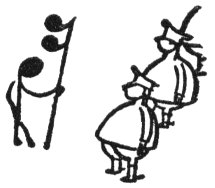
MARCHING NOTES
Books by
ERNEST LA PRADE
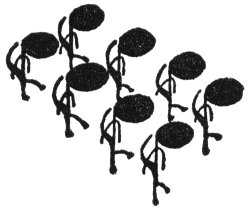
ALICE IN ORCHESTRALIA
MARCHING NOTES
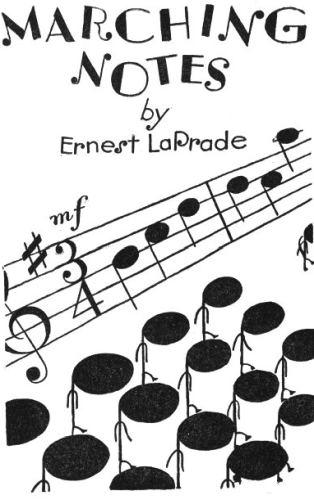
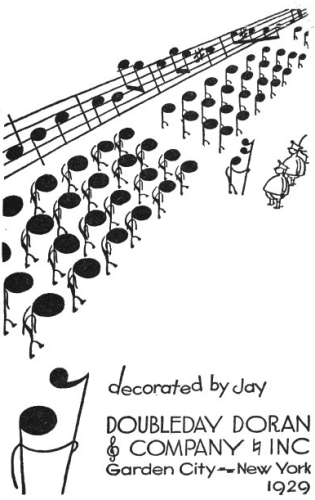
COPYRIGHT, 1929
BY DOUBLEDAY, DORAN & COMPANY, INC.
ALL RIGHTS RESERVED
PRINTED IN THE UNITED STATES AT
THE COUNTRY LIFE PRESS
GARDEN CITY, N. Y.
| CONTENTS | ||
| CHAPTER | PAGE | |
| I | THE MAJOR | 3 |
| II | THE GREAT STAFF | 19 |
| III | A NICE MESS | 37 |
| IV | RULES AND REGULATIONS | 53 |
| V | BETWEEN THE BARS | 69 |
| VI | ALICE TAKES COMMAND | 91 |
| VII | GUIDEPOSTS | 111 |
| VIII | MUSICAL ARTILLERY | 129 |
| IX | ALICE RECOGNIZES AN OLD ACQUAINTANCE | 145 |
| X | THE GENERAL ARRIVES | 159 |
| XI | THE GENERAL DEPARTS | 179 |
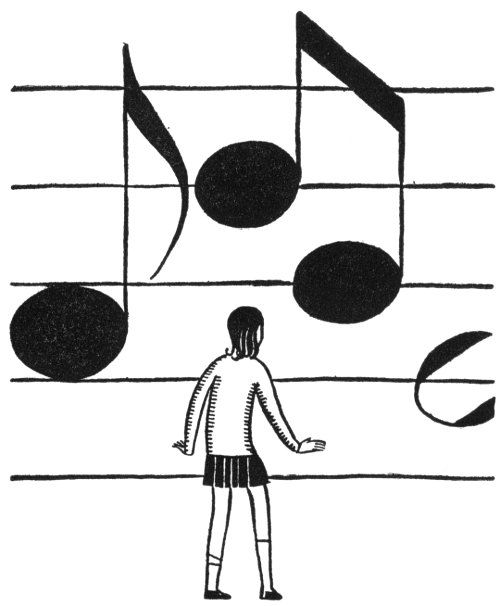
THE MAJOR
Alice had a new piece. Her lesson having been well prepared, her piano teacher had told her that she might begin to study a new composition: the Minuet Number 1 with Trio, by Mozart. Accordingly, on her way home, she had stopped at the music shop to buy a copy of the minuet, and now she was eager to find out what it was like. As soon as she reached home she ran to her piano, placed the new music on its rack, and began to try it over.
She was not a highly accomplished pianist; but considering her age, which was ten years, and the fact that she had been taking lessons for little more than one of those years, she was a rather good sight reader. She had an alert mind, a quick eye, and a good musical ear; and, most important of all, she was tremendously fond of music and worked very hard. She enjoyed practising the piano. Even scales and exercises interested her, and the pieces which she played herself, or heard others play, filled her with delightful, mysterious emotions. They seemed to be trying to tell her something which she could not quite understand but which she felt was exciting or soothing, gay or sad; and she was constantly trying to find out more definitely what their messages meant.
For Alice was both observant and curious. She noticed a great deal of what went on about her, and she always wanted to know the reason for everything. One of the things she had noticed was that certain pieces of music appealed to her much more strongly than others, and she often wondered why they did so. It was not because they were longer or shorter, faster or slower, or louder or softer than the others. That much she was sure of. But, try as she would, she could not discover what it was that made one piece sound “prettier” than another. This new minuet, for instance—what made it so charming? It was really very simple. Already she had learned to play it fairly well.
“Why,” she said to herself, “it’s easy. There’s nothing to it. And yet, there is something to it, after all, because it’s one of the prettiest pieces I’ve ever played. It’s so nice and jolly and—and old-fashioned. It sort of reminds me of something that happened a long time ago—something awfully nice, I’m sure, but I can’t quite remember what it was. I wonder why it sounds so old-fashioned. I wonder why it’s different from any of my other pieces. Pieces all look so much alike—why do they sound so differently? They’re all made up of notes and rests and bars and things, but how are the notes put together to make music? I ought to know that. I can play music; why can’t I compose it?”
She pondered a moment; then her face suddenly brightened.
“P’r’aps I can compose music!” she exclaimed. “I’ve never tried. Maybe if I just play any notes I happen to think of it will be music.”
She poised her hands over the keyboard and then let them fall at random on the keys. The result was a harsh discord.
“Oh, dear!” she cried, “that doesn’t seem to be the way. I s’pose I don’t know enough about it. There’s so much that I don’t know. For instance, how many notes make a piece? And why do some notes sound well together and some not? And when you compose a piece, how do you begin, and what do you do in the middle, and how do you end?”
She leaned back in her chair and gazed in perplexity at the notes of the Mozart minuet. They had suddenly turned into a riddle, which she tried vainly to solve. Why was it that she could read them but hadn’t the least idea how they were written? It was as if she had learned to read words without knowing how to spell even so much as “cat.” That was clearly impossible. Why, then, were notes so different from letters?
Alice stared hard at the notes, as if hoping that they might tell her the answer to the riddle; but they merely stared stupidly back at her. Suddenly she sat up straight and blinked. Were her eyes playing pranks, or had she really seen a note move from one measure to the next?
“Well, of all the queer——” Alice began, and then stopped, her eyes wide with astonishment. Another note had changed its place on the staff.
“I do believe they’re alive!” she Whispered excitedly. “They are alive—and they’re growing bigger and bigger!”
It was true: the notes had come to life and were growing up at an amazing rate. Already they were nearly as tall as Alice herself; and the lines and spaces of the staff had grown longer and longer and wider and wider, until they had turned into a great flight of stairs which stretched away on either side as far as Alice could see. The bottom step was black, the next one white, the third black, and so on, up to the topmost step, which was black. Alice counted the steps and found that there were nineteen in all. Above the top step she could see nothing but sky, while at the bottom of the stairs the ground sloped sharply down to where she was standing—for she was no longer seated at her piano. The piano, the chair, and all the familiar objects of her room had vanished, and she found herself in a strange country which appeared to be covered with snow. However, as she didn’t feel the least bit cold she concluded that it must be some new kind of snow that was warm and never melted, even in summer. There was nothing of interest to be seen anywhere except on the stairs, where the notes, now grown taller than Alice, were moving up and down and from side to side in a bewildering manner. Alice was staring at them, wondering what they could be doing, when she was startled by the sound of a low, rich voice speaking close to her ear.
“Pardon me,” said the voice, “would you mind standing aside? I have orders to place a Low C just here.”
Alice turned quickly to see who it was that had spoken. To her surprise there seemed to be nothing near except a large bass clef suspended in midair at about the height of her own head. It appeared so unreasonable that a bass clef should be endowed with the power of speech that Alice thought her ears must have deceived her. She was not left long in doubt, however, for the voice spoke again.
“I’m very sorry to disturb you,” it said, “but I really must beg you to stand a little farther down the hill. My orders, you know . . .”
“Oh, excuse me,” said Alice. “I didn’t mean to get in your way, but at first I—I didn’t see you.”
As a matter of fact she was not sure that she saw the person who had addressed her even now. But as she stared harder and harder she thought she could just make out the figure of a queer-looking man, rather short and stout, and dressed all in white. His face too was white—even his hair was white. The only thing about him which was not white was the large bass clef embroidered in black on the breast of his tunic, or blouse, which seemed to be of a military cut. The rest of him was so exactly the color of the surrounding landscape that it was almost impossible to see him. He seemed to realize Alice’s difficulty, for he said kindly:
“You will be able to see me better when your eyes have become accustomed to the glare. In such a white country as this the light is dazzling to human eyes. But, in the meanwhile, may I remind you that you are still standing just where I have to place the Low C?”
“I beg your pardon!” Alice exclaimed, blushing and moving hastily aside. “I was trying so hard to see you that I quite forgot——”
“Please don’t mention it,” said the Bass Clef courteously. “I hate to be so persistent, but the General, you know, is very exacting, and if we don’t carry out his orders without delay we are likely to be court-martialed.”
“I s’pose that must be very unpleasant,” said Alice. “I hope he won’t court—won’t do it to you. Does it hurt much?”
“Sometimes it’s rather painful,” the Bass Clef admitted. “No soldier enjoys being court-martialed; but he’s not apt to be if he does his duty properly.”
Alice was just about to ask what it was like to be court-martialed, for she had only the haziest notion of what the word meant; but at that moment she noticed that on the spot where she had been standing, at the foot of the great flight of stairs, four short steps—two black and two white—had appeared as if by magic. The Bass Clef barked a command:
“Corporal Crotchet, take your post!”
Instantly a quarter note detached himself from the throng on the stairs, ran down to the flight of four short steps that had just appeared, and stood stiffly at attention on the black step at the bottom. Alice stared at him for a moment, perplexed. There was something queer about him. In a moment she saw what it was and began to laugh. The note was standing on his head.
“Why does he stand upside down?” Alice asked the Bass Clef.
“Merely for the sake of neatness,” he replied. “You see, according to regulations, his head must be on the step—or, as you call it, the Line or Space of the Staff—which he is ordered to occupy. If he stood right side up, with his head on the lowest step, his body—I believe you call it ‘Stem’—would extend far down below the Staff. That would look untidy; and soldiers, you know, are always very neat and orderly. Therefore, as a rule, when a note is assigned to a step below the middle of the Staff he stands on his head; and when his place is above the middle he stands right side up.”
“I see,” said Alice. “So the notes are really soldiers?”
“Of course—and good soldiers, too. They always obey orders.”
Alice gazed curiously at the Bass Clef. She could see him quite well now, and she noticed that, besides his military-looking blouse, he wore a jaunty cap, a belt with a strap over his right shoulder, riding breeches, and white boots with spurs.
“Are you a soldier too?” Alice inquired.
“Naturally,” said the Bass Clef, drawing himself up proudly. “I am a staff officer with the rank of major, and I exercise command over the lower half of the Great Staff. The upper half, you know, is under the command of my friend Major Treble Clef. Then there’s another staff officer, Major C-Clef, who controls the middle portion of the Great Staff; but he’s nearly always on leave of absence nowadays. Except when we are engaged in a campaign for the viola, the ’cello, the bassoon, or the trombone, he generally delegates his authority either to Major Treble Clef or to me, or else he divides it between us, as in campaigns for the piano.”
Alice looked confused. “I’m afraid I don’t quite understand,” she said. “What do you mean by ‘campaign’?”
“The same thing you mean by ‘composition,’ ” the Bass Clef replied. “If you’d ever taken part in one, as we have, you’d realize that ‘campaign’ is the only word that correctly describes it. But human beings seem to have a mania for calling things by stupid and inaccurate names. What possible reason, for instance, can there be for calling our Great Stairs the ‘Great Staff,’ and its steps ‘lines and spaces’? A ‘staff’ is a ‘stick,’ or, in the army, a board of officers; and lines and spaces have nothing to do with steps.”
Alice felt that the Bass Clef was not entirely just in his criticism of human beings.
“But,” she pointed out, “in my country they are lines and spaces. I s’pose that’s because they’re easier to print.”
“It’s just your stinginess,” grumbled the Bass Clef. “Instead of providing us with nice roomy stairs to maneuver on, you print us on flat pieces of paper and shut us up in books. It’s very inconsiderate.”
“I’m sorry,” said Alice. “I—I don’t think we ever s’posed you minded. Besides, if you took up as much space in my country as you do here, nobody would play you, because they’d have to walk miles and miles to read one piece.”
Apparently the Bass Clef had not thought of that. “Well, perhaps you’re right,” he conceded. “But I do wish you’d call things by their proper names. Anybody can see that this is really a flight of stairs; but since you insist on calling it the ‘Great Staff’ we have to call it by the same name, to avoid still more confusion.”
“What do you mean by ‘Great Staff’?” Alice inquired. “I know what the Treble Staff and the Bass Staff are, but I’ve never heard of a ‘Great Staff.’ ”
“Fancy that!” exclaimed the Bass Clef. “Then it’s high time you learned about it, if you ever expect to read music.”
“But I can read music,” Alice protested. “My teacher says I read very well—for my age.”
The Bass Clef looked politely skeptical, and Alice added:
“Anyhow, I’d be very much obliged if you’d explain about the Great Staff—if you have time.”
The Bass Clef glanced at his wrist watch. “Very well,” he said. “I can spare a few minutes. But first I must dismiss these troops.”
He beckoned to two handsome young officers
who were standing near by. As they approached,
Alice saw that one of them wore on his White
tunic the fraction  , while the other had the
word “Allegro” embroidered in black letters
across his breast.
, while the other had the
word “Allegro” embroidered in black letters
across his breast.
They halted in front of the Bass Clef and saluted.
“The battalion is dismissed,” said the Bass Clef.
The two officers saluted again, about-faced, and barked some words which Alice did not understand. However, the notes seemed to understand them, for they promptly formed a column of squads and marched off along the stairs.
“These gentlemen,” said the Bass Clef, “are my aides, Lieutenant Rhythm and Lieutenant Tempo. Charming fellows, both of them, and really indispensable. They direct the actual movements of all our troops. Now, if you’ll just step up here with me I’ll show you what we mean by the ‘Great Staff.’ ”

THE GREAT STAFF
The Bass Clef led Alice up the stairs. Halfway to the top they came to a very broad white step which formed a kind of landing. Here the Bass Clef paused and asked abruptly:
“Do you know where we are?”
Alice looked up the stairs, then down.
“Why, we seem to be about halfway between the top and the bottom,” she replied.
“Exactly,” said the Bass Clef. “We are on the middle step which separates the Bass Staff from the Treble Staff.”
“Why is it so much broader than the others?” Alice inquired.
“To make music easier to read. Once there were three steps where this single broad step now is—two white steps with a black one between them. That black step was Middle C, so called because it was exactly in the middle of the Great Staff. It is also the C nearest the middle of the piano keyboard, as you probably know.”
Alice nodded her head, and the Bass Clef continued:
“Now, to avoid confusion, as I said before, we shall call the black steps ‘Lines’ and the white steps ‘Spaces.’ The Great Staff, then, formerly consisted of twenty-one steps—eleven lines and ten spaces—all so much alike that it was often hard to tell exactly which step a note was on without stopping to count up from the bottom or down from the top. For that reason we decided to leave out the middle black step entirely, thus dividing the Great Staff into two staves of nine steps each—five Lines and four Spaces—which makes it easier to tell where you are at a glance.”
“I see,” said Alice; “but what became of Middle C?”
“Why, he merely lost his permanent post and became what we call a ‘leger-step.’ That is, whenever he’s on duty he has a little private step of his own, just long enough for the note to stand on. When he’s acting under my orders his step is placed just above the Bass Staff, with one space between; when he’s serving under Major Treble Clef his step is placed in a similar manner just below the Treble Staff. Is that clear?”
“Ye-es,” said Alice, a trifle doubtfully; “but——”
“Then I’d better give you a demonstration,” said the Bass Clef. He blew a shrill blast on a whistle, and instantly a little soldier with a Sharp on the breast of his tunic came running along the stairs.
“This,” said the Bass Clef, “is Private Accidental, Captain Key’s orderly. He’s a very useful soldier; in fact, we could hardly get along without him.”
“What does he do?” Alice inquired.
“You’ll see him at work later on,” said the Bass Clef. “That will be better than having me explain his duties.”
The soldier, having arrived within a few paces of the Major, halted and saluted.
“Orderly,” said the Bass Clef, “ask Major C-Clef and Major Treble Clef to be good enough to step this way; and have Sergeant Semibreve report to me with a fatigue detail.”
“Yes, sir,” said the orderly, and dashed away to execute his orders. As he turned, Alice saw that on his back he wore a Flat.
A moment later two officers appeared, walking along the stairs toward Alice and her friend. In general appearance they both resembled the Bass Clef, for they were rather short and stout and wore white uniforms with boots and spurs; but the signs on their breasts were different. One of the newcomers had on his tunic an emblem somewhat like the symbol “&,” which Alice knew to be a treble clef. The other, however, wore a sign that was new to her. She had never seen anything quite like it before, though it looked somewhat like a large and ornate letter B.
The three officers saluted each other courteously, after which the Bass Clef presented his colleagues to Alice with due ceremony.
“Gentlemen,” he said, “I should like you to meet a young friend of mine who is interested in our country and our profession.”
The two officers saluted and then bowed, and Alice curtsied.
“I’ve undertaken to explain to her,” the Bass Clef continued, “the precise nature of our duties, and I’ve taken the liberty of calling on you to assist me in demonstrating some of their more complex phases.”
The two officers declared that they were happy to be of service.
“Among other things,” the Bass Clef went on, “I propose to show her, as clearly as possible, how the spheres of our authority fit together and, in certain cases, overlap. The first thing, of course, is to restore the Great Staff. Ah, I see that Sergeant Semibreve has arrived with his detail. Sergeant, have your men restore the Middle C.”
The Sergeant, a round, fat note without a stem, whom Alice recognized as a whole note, was in charge of a squad of eight privates. These were eighth notes, and they looked so comical, with their little tails sticking out stiffly behind, that Alice could not help smiling at them. However, she soon forgot the drollness of their appearance as she became absorbed in watching what they were doing. For at a word from the Sergeant they had set to work with astonishing energy, and in less time than it takes to tell it they had removed a long section of the broad middle step, replacing it with three steps of the ordinary size, one white, the next black, and the third white. The Great Staff now appeared as the Bass Clef had described it—that is, it consisted of an unbroken series of twenty-one steps, alternately black and white.
“Now, gentlemen,” said the Bass Clef, “let us take our stations.”
He walked a few paces to the left, descended to the fourth Line from the bottom, and halted. The other two placed themselves directly above him, the C-Clef on the sixth Line and the Treble Clef on the eighth.
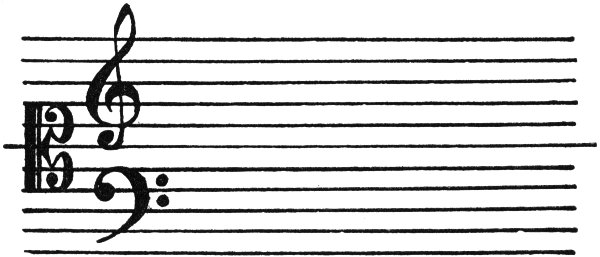
“You will see now,” said the Bass Clef to Alice, “how we define the parts of the Great Staff on which our notes operate. As you already know, I suppose, each of us controls a Staff of nine steps—five Lines and four Spaces—together with as many leger-steps as we may need. Now, my Staff comprises the nine lowest steps of the Great Staff. Therefore, when you see a five-Line Staff with a bass clef at the beginning, you know that the notes appearing on it represent the lowest tones of the scale—those that fit the compass of a bass voice. Just a moment and I’ll make that clearer. Sergeant, clear the field for the Bass!”
The squads of eighth notes scurried about, lifting out sections of the upper steps and carrying them away. When they had finished, all the steps above the ninth, for a distance of several yards, had disappeared, leaving the nine lowest ones presided over by the Bass Clef.
“Why,” said Alice, “it looks just like the left-hand part in piano music—only, there aren’t any notes on it.”
“That is easily remedied,” the Bass Clef assured her. “Sergeant, have your squad take Scale Formation Number 1.”
The Sergeant said something that sounded to Alice like three snorts and a sneeze, whereupon the eighth notes promptly ranged themselves in a diagonal line leading up the Staff from left to right, one note on each step. The first note stood on the second Space from the bottom, while the last two notes occupied short leger-steps above the Staff.
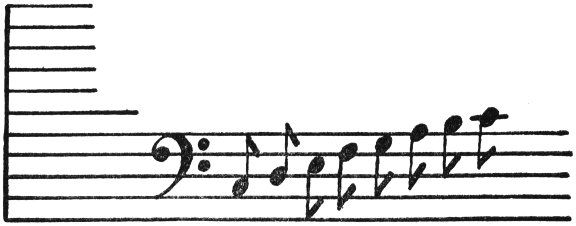
“Do you recognize that formation?” the Bass Clef demanded.
“Yes,” said Alice. “It’s the scale of C. Shall I sing it for you?”
The Bass Clef smiled. “I’m afraid you can’t.”
“Why, of course I can!” cried Alice. “Just listen—I’ll prove it:
“Do, Re, Mi, Fa, Sol, La, Si, Do.”
Her voice was musical and very high, and she sang the tones of the scale in perfect tune. But the Bass Clef chuckled, and Alice flushed.
“What’s the matter?” she demanded. “Wasn’t that right?”
“Relatively, yes,” said the Bass Clef, “but not absolutely. You sang a very good scale of C, but it wasn’t this one. Yours was in the treble range, two octaves higher.”
“Oh, well,” said Alice a bit sulkily, “it’s all the same.”
“That is a very thoughtless remark,” said the Bass Clef reprovingly. “How can it be the same? Bass is bass and treble is treble. If that were not the case I should lose my job, and so would a lot of others—the majority of your piano keys, for instance. Tell me, how many octaves has your piano keyboard?”
“Seven,” said Alice promptly.
“And a quarter,” the Bass Clef added. “Now, then, does the lowest octave sound the same as the highest?”
“Oh, no,” said Alice.
“Do the tones of any octave sound exactly like the tones of any other?”
Alice had to admit that they did not. “But what am I to do,” she asked, “if I want to sing music that’s written in the bass? I can’t sing such low notes.”
“Nor can anyone else,” said the Bass Clef curtly. “Notes can’t be sung, any more than letters can be spoken. They are merely the symbols that represent musical sounds, just as letters are symbols that represent words. You can read notes, but what you sing are tones. Now, I wonder whether you know exactly what a note does represent?”
“Why, it shows what note—I mean, what tone—you’re s’posed to sing or play.”
“Are you sure?” The Bass Clef’s voice was ironic. He pointed to a spot out on the bare white plain below the Staff, where a lone sentry—a sixteenth note with two tails—was slowly pacing up and down.
“Do you see that note out there? Well, what tone does he represent to you—a high one or a low one?”
Alice was stumped.
“I—I can’t tell,” she admitted.
“Why not?” demanded the Bass Clef.
“Because there aren’t any Lines or Spaces.”
“There you are!” cried the Bass Clef triumphantly. “That proves that a note does not represent pitch—that is, the position of a tone up or down the scale. He only indicates a definite pitch when you place him on the Staff; so it’s really the Lines and Spaces of the Staff that show you which tone of the scale you are to sing or play. However, there is something that the note does show you, whether he’s on or off the Staff. Do you know what that is?”
Alice considered the question for a moment; then her face brightened.
“I know!” she cried. “He shows how long the tone is s’posed to last.”
“Right,” said the Bass Clef. “You’ve got it straight at last. I hope you won’t forget it. And now I think we’ve kept the other majors waiting long enough while we’ve been arguing. Let’s ask them to give us a demonstration of their duties. Major Treble Clef, will you take command?”
“Certainly,” said the Treble Clef in a high, sweet voice. “Sergeant, clear the field for the Treble.”
Once more the squad of eighth notes set to work, and soon the Staff had been rearranged so that only the nine highest steps were visible, with the Treble Clef in his place at the left-hand end.
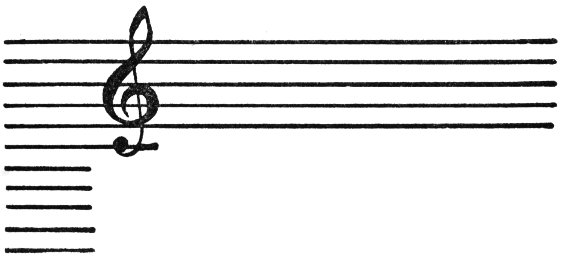
“There,” said the Bass Clef, “you have the part of the Great Staff which is used in writing for the soprano voice, the violin, and various other instruments of high pitch; and also, of course, for the right-hand part in piano music. Now, if Major C-Clef will take command, you shall see how his part of the Great Staff is situated in relation to Major Treble Clef’s and mine. I doubt if you are as familiar with his sphere of authority as you are with ours.”
The C-Clef obligingly assumed command and ordered Sergeant Semibreve to restore the Great Staff. As soon as the twenty-one steps were again in their proper places the C-Clef addressed Alice in a full round voice of medium pitch.
“Please notice particularly,” he said, “that my post is on Middle C—the sixth Line of the Great Staff, counting either up or down—and that I always remain on Middle C so long as I am on duty. That’s why my name is C-Clef. Now, I command two different Staves—the Alto Staff and the Tenor Staff—each composed of five Lines and four Spaces; but in the Alto Staff Middle C is the third Line, and in the Tenor Staff it’s the fourth Line. Therefore, if you compare these two Staves, apart from the Great Staff, it looks as if my post were on a different Line in each Staff; but that is an optical illusion, as I shall show you by means of the Dotted Lines. Sergeant, change Lines; Alto, dotted!”
Again the Sergeant snorted and sneezed, and again the eighth notes scurried about in obedience to his commands. Seizing the middle step—the Line on which the C-Clef was standing—they turned it bottom side up. How they accomplished this without upsetting their commanding officer was a mystery to Alice; but they managed it somehow, for there stood the C-Clef, just as before, except that the step he stood on was now black-and-white, so that from a distance it looked indeed like a dotted, or broken, Line. The industrious eighth notes then turned over the two Lines above the middle one and the two below it, so that the five middle Lines of the Great Staff were now dotted.

“Now, young lady,” said the C-Clef, “these dotted Lines, with the Spaces between them, constitute the Alto Staff. As you see, its middle Line is Middle C, its two upper Lines are the same as the two lowest Lines of the Treble Staff, and its two lower Lines are the same as the two highest Lines of the Bass Staff.”
“I can see that,” said Alice, “even if it does sound rather complicated. But what I should like to know is what the Alto Staff is good for.”
“Originally,” said the C-Clef, “it was used in writing music for the alto voice and for various instruments whose compass extended about an equal distance above and below Middle C. By writing for such instruments on this Staff you avoided using a lot of leger-steps. Nowadays, however, it is seldom used except in music for the viola, the alto instrument of the ‘string’ family. Nevertheless, you should be familiar with it—and with the Tenor Staff, which I shall show you in a moment—for otherwise you will not be able to read an orchestral score. Now, Sergeant, change Alto to Tenor.”
In a jiffy the topmost dotted Line was changed to black again, and the first black Line below the remaining dotted ones was changed to a dotted Line.
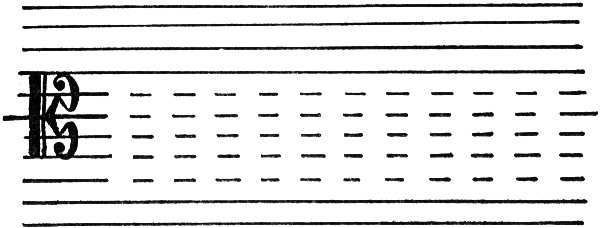
“Here you have the Tenor Staff,” said the C-Clef. “You see, my post is on the fourth line of this Staff; and yet I haven’t budged from Middle C.”
“I understand,” said Alice. “It’s the steps that have changed—not you. But what is the Tenor Staff used for?”
“Formerly it was used in writing for the tenor voice and for instruments of tenor pitch, but now it is employed only in writing for the upper ranges of the ’cello, the bassoon, and the trombone.”
The C-Clef paused and glanced inquiringly at Alice. “Do you think you’ve got the different divisions of the Great Staff clear in your mind now?”
“Yes,” said Alice, “I think I have.”
“Very well, then, it seems to me we’ve had enough discussion of musitary matters for the present. Speaking for myself—I’m hungry; so I propose that we all go and have lunch at the Officers’ Club.”
“Oh!” cried Alice, “that would be nice! I’m hungry too. But please tell me,” she begged, as they started to walk away, “what ‘musitary’ means.”
“It’s a combination of ‘musical’ and ‘military,’ ” the C-Clef explained. “You’ll find it a useful word, because it reminds you that the art of music is like the army—you can’t get far in either without discipline.”
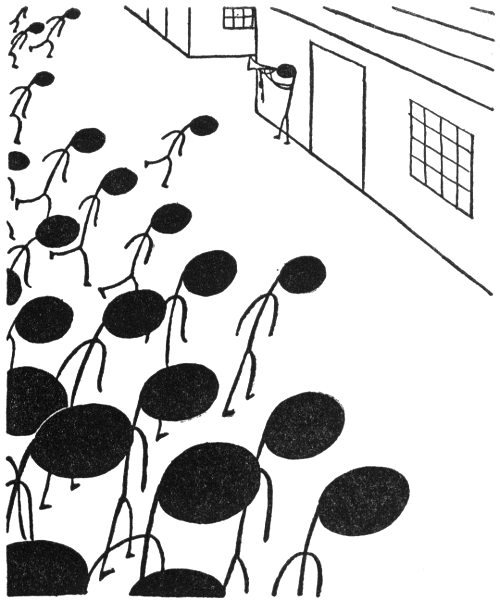
A NICE MESS
Alice and the officers walked briskly along until they came to an opening like the entrance to a cellar, with steps leading downward underneath the Great Staff. Here the C-Clef paused and offered Alice his arm.
“You’ll find it rather dark down below,” he said. “If you don’t know the way it’s somewhat confusing. I think you’d better let me guide you.”
Alice thanked him and laid her hand in the crook of his elbow. Then they all entered the opening and started down the steps. Soon it grew dark as pitch, and Alice clung tightly to the C-Clef’s arm for fear of stumbling; but the officers marched right on as if they knew every step of the way. Presently they halted, a door swung open, and Alice found herself once more in broad daylight. At first she was dazzled, but her eyes soon adjusted themselves to the glare, and she saw that she was standing at the edge of a large square field which was covered with short grass and surrounded by a border of trees. The grass was rather peculiar, however, for instead of being green it was white; and the trees too were white, and had snow-white leaves.
“This,” said the C-Clef, “is the Parade Ground—the center of our Musitary Post.”
“My!” Alice exclaimed, “it does look neat. But why is it that everything in your country is white—everything, at least, but the notes, and the Lines of the Great Staff, and the signs you wear on your breasts?”
“Because,” the C-Clef explained, “they are the really important things for you to see. Ordinarily it doesn’t matter whether you see us and the grass and trees of our country or not. In fact, human beings never do see us unless they pay us a visit, as you are doing, and remain long enough for their eyes to get used to the peculiar light. Otherwise, when they see the clef on my breast they think that’s all there is to me. They never guess that the rest of me exists at all; but I don’t mind that. I’m far too busy to worry over such unimportant details. However, now that you are here and your eyes have grown sharper, I shall point out some of the principal features of our post. I think you’ll find them interesting.”
The C-Clef pointed to the farther side of the Parade Ground, where there was a row of long, low houses, all painted white.
“Those,” he said, “are the barracks, where the notes, or enlisted men and noncommissioned officers, live; and on this side of the Parade Ground you see the administration buildings, the commissioned officers’ quarters, and the Officers’ Club. The little square building with a flagstaff in front of it is Post Headquarters, where the Colonel has his office. But there goes mess call. If we don’t hurry we shall be late.”
As he spoke, a note who had come out of Headquarters placed a bugle to his lips and blew a melodious call; and immediately the post, which had appeared practically deserted, was filled with a throng of hurrying soldiers. On the farther side of the Parade Ground notes of every description were tumbling out of the barracks and forming in ranks, while on Alice’s side officers came hurrying from every direction toward the large building which had been pointed out to her as the Officers’ Club.
Alice and her three friends also hurried toward the clubhouse and presently found themselves in the dining room—or, as the officers called it, the mess hall. “Mess,” the C-Clef told her, was the army word for “meal.” Alice thought that rather peculiar and wondered whether the lunch would be a messy affair. She had visions of soup spilled on the tablecloth, of greasy dishes and unappetizing food; but her fears were soon dispelled, for the tablecloth proved to be spotless, the dishes clean, and the food excellent—though every bit of it was white, even the meat and vegetables.
There were several other officers, besides the
three majors, at Alice’s table. They were very
polite and took great care to see that she had
everything she wanted, but they seemed a little
shy and embarrassed, conversing among themselves
in low voices, as if they didn’t quite know
what to say to their visitor. Alice was rather glad
of that, for she felt somewhat shy herself; and,
besides, it gave her a chance to look about her
and get a clear impression of the mess hall.
Everything, of course, was white. The floor, the
walls, the ceiling, the tables, the chairs—all were
of the same snowy whiteness. It looked very clean
and cool, but Alice thought it a bit monotonous
and rather too much like a hospital. “However,”
she thought, “I s’pose I’ll get used to it,” and she
began to take stock of her companions at table.
Among them were the two young lieutenants
whom Alice had seen on the Great Staff, and
presently she noticed that one of them, whose
insignia when she had last seen him was the
fraction  , now wore a different emblem; for
on his breast was a large letter C with a line
drawn vertically through it. She was just wondering
what the change meant when, to her astonishment,
the letter C changed to
, now wore a different emblem; for
on his breast was a large letter C with a line
drawn vertically through it. She was just wondering
what the change meant when, to her astonishment,
the letter C changed to  , and then
to
, and then
to  . Nudging the Bass Clef, who sat at her right,
she whispered excitedly:
. Nudging the Bass Clef, who sat at her right,
she whispered excitedly:
“Look—look! What makes him change like that?”
“Who?” asked the Bass Clef, laying down his knife and fork.
“That lieutenant at the other end of the table. The figures on his breast keep changing.”
“Oh,” said the Bass Clef, “you mean young Rhythm. He is rather a changeable fellow; but that’s nothing against him. His duty, you know, is to stand on the Staff, close beside me, and show how many beats are to be counted to each measure. Therefore, whenever the General orders a change of rhythm the Lieutenant has to change the figures on his breast, which are known as the Rhythm Signature.”
“I see,” said Alice; “but why is he changing them now?”
“Why, that’s his way of blushing. He’s a bashful young chap, and he’s probably embarrassed because you’re looking at him.”
“Oh, I’m sorry!” Alice exclaimed. “I didn’t mean to be rude. I shan’t stare at him any more.”
She turned her eyes to the other side of the table, where the other lieutenant whom she had seen on the Staff was sitting. Hardly had she glanced at him when the word “Allegro” on his breast changed to “Agitato.”
“Oh, dear!” she said, “that one’s blushing too—the one you said was Lieutenant Tempo.”
“So he is,” said the Bass Clef. “He’s as bashful as the other one, and even more changeable. His job is to show how fast or how slowly the General wants the notes to move; and as the General frequently changes his mind on that point Lieutenant Tempo frequently has to change his emblem at a moment’s notice.”
“Are all the officers changeable, like the two lieutenants?” Alice inquired.
“No,” said the Bass Clef; “there’s only one other who changes. That’s the captain sitting there at the right of Lieutenant Rhythm—the moody-looking officer with two Flats on his tunic. His name is Key Signature, but we usually call him Captain Key, to save time. Look!—there he goes. He’s changing now.”
The Captain’s gloomy eyes had begun to sparkle with mirth, and he broke into a hearty laugh. As he did so, Alice saw the two Flats on his breast vanish and a single Sharp appear in their place. She hadn’t the least idea what he was laughing at, but somehow she felt inclined to laugh too.
“Why,” she said, “a moment ago he looked as if he’d lost his last friend, and now he’s as cheerful as he can be.”
“That’s because he has changed from minor to major,” the Bass Clef explained.
Alice looked puzzled. “I thought you said he was a captain.”
“So I did,” said the Bass Clef.
“But how can he be a captain and a major too?”
“He isn’t,” said the Bass Clef.
“But you said——”
The Bass Clef interrupted her impatiently.
“I said that he had changed from minor to major. That meant that his mode had changed. It’s perfectly simple.”
“I s’pose I’m awfully stupid,” Alice apologized, “but it seems all mixed up to me.”
The Bass Clef heaved a sigh.
“Well,” he said, “I’ll try to explain it. You see, the word ‘major’ has several different meanings. As a military term it is the title of an officer next in grade above a captain. In the military sense, I’m a major. But in music ‘major’ means ‘larger’ and refers to the size of an interval or the kind of a mode; and as this is a musitary organization we use the word in both senses—which may be a bit confusing to a civilian, I suppose. However, if you understand the meaning of ‘interval’ and ‘mode,’ I think I can make the rest of it clear.”
“But I’m afraid I don’t,” said Alice.
The Bass Clef shrugged his shoulders.
“There you are!” he exclaimed indignantly. “That shows how little you civilians know about musitary life. Now, you’ve probably been taking piano lessons for three or four years——”
“Oh, no!” Alice broke in; “only one year.”
“That’s quite bad enough,” said the Bass Clef. “As I was about to say, here you’ve been taking piano lessons for a whole year and you haven’t learned what an interval is. It would be just as sensible to try to ride horseback without learning what a saddle was. It’s shocking—that’s what it is. If I were you, as soon as I got home I’d ask my teacher to recommend a good textbook on Musical Theory and Harmony, and I’d set to work and learn all about them.”
“I will,” Alice promised; “but I do wish you’d explain about the interval now.”
“Very well,” the Bass Clef agreed, “I’ll try:
“In music, an interval is the distance, reckoned in steps of the scale, between two tones; and it takes its name from the number of steps it includes. For instance, the interval C—E is called a third, because it includes the three steps C, D, and E. An interval that includes two steps is called a second, one that includes four steps is called a fourth, and so on, up to the octave, which is an interval containing eight steps.
“However, there are intervals that contain the same number of steps and yet are not exactly the same size, owing to the fact that some steps are whole steps and some are half steps. C—E flat, for example, is also a third, because it also includes three steps, but it is actually a half step smaller than the interval C—E. Therefore, in order to distinguish between them we call the larger third ‘major’ and the smaller one ‘minor.’
“Now, the word ‘mode’ means the fashion or manner in which the whole steps and half steps of the scale are arranged. Do you know how many half steps there are in a scale?”
“Oh, yes!” said Alice, eager to prove that she was not entirely ignorant of musitary matters. “There are two of them. The first one comes between E and F, and the second comes between B and C.”
“Well,” said the Bass Clef, “that’s where you find them when your scale is in the key of C major. But if it’s in a different key or in the minor mode the half steps will be found in other places. A scale is in the minor mode when its third tone is a minor third above its first tone. If the third tone is a major third above the first, the scale is in the major mode. For instance, in the scale of C minor the third tone is E flat, and in the scale of C major the third tone is E natural.”
The Bass Clef paused to drop a lump of sugar into his cup of white coffee, which he proceeded to stir meditatively.
“There’s another word,” he resumed presently, “whose meaning you must clearly understand. That’s the word ‘key.’ I wonder if you can give me a definition of it.”
“Do you mean the kind of key that unlocks a door?” Alice asked.
“No,” said the Bass Clef, smiling, “I mean a musical key. And yet they are somewhat alike, after all—only it would be better to say that a musical key is something that locks a door. For a musical key locks the door, so to speak, against all tones except those that belong to the particular scale in which a piece of music is written. You see, ‘key’ means almost the same thing as ‘scale,’ the chief difference being that the tones of a scale always occur in consecutive order, one to each step of the Staff, while the tones of a key may occur in any order you please. When we say that a piece is in the key of C we mean that its tones are those of the scale of C and that all other tones must keep out—unless we send an orderly with an ‘accidental’ Sharp or Flat or Natural to open the door for them. Does that solve the puzzle?”
“It makes it much simpler,” said Alice. “But how do you decide what key to write a piece in?”
“The General decides that. Then Captain Key Signature takes his post on the Staff, just beside me, and indicates by the number of Sharps or Flats he wears which key the General has chosen to use. For example, one Sharp shows that the key is G major or E minor; one Flat indicates F major or D minor, and so forth. If you don’t know the signatures of all the other keys, or how to tell whether the key is in the major or minor mode, you will have to learn those details when you get your Theory textbook, for I haven’t time to explain them now. Here comes the dessert, and after mess I must take you to call on the Commanding Officer. It’s considered good form for all visitors to call on the C. O.—and our C. O. is a great stickler for form. He’s a charming gentleman, though, and I’m sure you’ll enjoy meeting him.”
“Is he the general you’ve mentioned so often?” Alice inquired.
“Oh, dear, no!” said the Bass Clef. “The General is a far more important person. Our C. O. is merely the commandant of this post. His name is Colonel Form.”
“I’m sure he must be very nice,” said Alice; “but I do so want to see the General. Do you s’pose I shall?”
“Perhaps you’ll see him very soon. We never know when he’s going to appear. He’s liable to pop up at any moment, and when he does he makes things hum, I assure you. Now, if you’ve quite finished your dessert we’d better go and call on the Colonel.”
Alice said good-bye to the other officers at her table and then followed the Bass Clef toward the door. Just as they were leaving the mess hall Captain Key’s jolly laugh rang out above the clatter of dishes and the hum of conversation; and again Alice felt inclined to join in his laughter.
“Goodness me!” she exclaimed, “the Captain is in a merry mood, isn’t he?”
“Yes,” said the Bass Clef, “he’s still in the major mode. You see, ‘mode,’ in a sense, means very much the same thing as ‘mood.’ Major mode—glad mood; minor mode—sad mood. There’s no better way than that to describe them.”
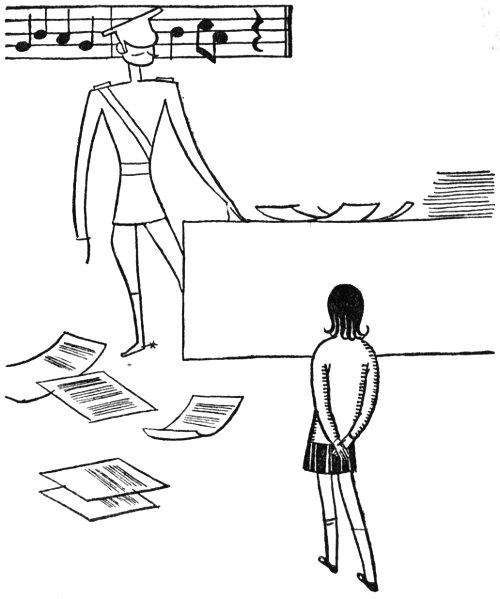
RULES AND REGULATIONS
As Alice and the Bass Clef left the mess hall they overtook a number of officers who had finished their lunch and were returning to their various posts of duty. Alice noticed that they walked less rapidly now than when the bugle had summoned them to mess; also, they looked slightly drowsy and a bit puffy in the region of the waist line. “They seem to be a good deal like human beings when it comes to eating,” she reflected. “I shouldn’t be surprised if they’re like human beings in other ways too, when you get to know them. I think they’re nice—specially the Bass Clef. He’s a little cross now and then, but I don’t blame him. I do make him answer lots of questions, and most people hate to answer questions. The other officers are nice too, and they all look splendid in their white uniforms. I wonder whether the Colonel is as nice as the rest of them.”
At this point her speculations were interrupted by the Bass Clef, who said cheerily:
“Here we are. This is Headquarters. I hope the Colonel will have time to see us. He’s a busy man, you know, but he’s very punctilious about receiving visitors, unless it’s quite impossible.”
They had entered the little square building near the flagstaff and were in a sort of corridor with rooms on either side. Through the open doors of these rooms Alice could see notes of all kinds working industriously at various tasks. Some were seated at tables, writing or adding up tall columns of figures, while others bustled about with their hands full of important-looking papers.
“Those,” said the Bass Clef, “are the regimental clerks. They do the ‘paper work’ of the post—that is, they keep records and accounts, make copies of the General’s campaign plans, write letters, and make out the orders that are issued from Headquarters. It keeps them busy, as you can see. Now we shall find out whether the Colonel can receive us. This is his office.”
They had reached the last door on the left of the corridor. Entering it, they found themselves in a small room furnished only with three or four chairs and a bench on which an orderly was sitting. The orderly sprang to attention, and the Bass Clef said:
“Find out whether the Colonel will see Major Bass Clef and a visiting civilian.”
“Yes, sir,” said the orderly. “Will the Major and the visitor be seated?”
They sat down, and the orderly vanished through a door marked
COMMANDING OFFICER—PRIVATE
“Goodness!” Alice exclaimed. “I shall never get these musitary terms straight.”
“What’s the matter now?” demanded the Bass Clef.
“Why, that sign on the door—it says the Commanding Officer is a private, and you said he was a colonel.”
The Bass Clef laughed. “That’s a good one! Who ever heard of a private soldier commanding a regimental post? No, my dear, that sign means that the door leads to the Colonel’s private office.”
“Oh, of course!” said Alice, blushing. “I might have known that. How stupid of me!”
“Never mind,” the Bass Clef consoled her. “Musitary language and customs are always confusing to civilians at first. You’ll get the hang of them after a bit.”
Just then the door marked “Private” opened, and the orderly reappeared.
“The Colonel’s compliments, sir,” he said, “and the Colonel will be pleased to receive the Major and the visitor at once.”
“Good!” said the Bass Clef. “Come along, young lady,” and he ushered Alice into the private office.
It was a comfortable room, furnished with armchairs, a sofa, and a large flat-topped desk. Here, as in the mess hall, everything was snowy white except some maps of the Great Staff, drawn in black, which hung on the walls.
As they entered a rather severe-looking officer rose from his seat behind the desk to greet them. He wore no insignia on his breast, but on each of his shoulders was a silver eagle.
“Good-afternoon, Major,” he said, in a voice that sounded to Alice rather cold and formal. “I trust you are well. This young lady, I presume, is our civilian guest, whom I am happy to welcome on behalf of the regiment. Pray be seated; and excuse me a moment, I beg, while I sign these reports. They must be forwarded to General Headquarters at once.”
He resumed his place at the desk and began to write furiously, apparently having quite forgotten the existence of his visitors. They sat down on the sofa, and Alice whispered in her friend’s ear:
“I don’t believe he’s very glad to see us. Maybe we ought not to have interrupted him.”
“Don’t worry,” the Bass Clef Whispered. “He always seems stiff and formal at first. His name, you remember, is Form, and his job is to see that all campaigns are carried out along the exact lines specified by the General; so it’s not surprising that he’s grown to be rather precise and rigid in his manner. When you get to know him better you’ll find that he’s really very pleasant and hospitable. Anyhow, he’s an enormously important officer. It would be impossible to carry out any kind of campaign without him.”
“There!” suddenly exclaimed the Colonel, laying down his pen and gathering his papers into a neat sheaf. “Those matters are attended to. Now my time is at your disposal until half-past two, when I have to make an inspection of the artillery.”
“Oh,” said Alice, “have you got guns and things?”
“We have no rifles or machine guns,” the Colonel replied. “Those are destructive weapons for which we have no use; but we have some very fine canons.”
“Aren’t cannons destructive weapons too?” Alice asked.
“Ours are not,” said the Colonel. “They are musical canons.”
“But don’t they shoot?”
“No, indeed. Why should they?”
“Well,” said Alice, “I don’t see what good they are if they don’t shoot. I shouldn’t think you could do much fighting with them.”
“We don’t have to,” said the Colonel. “Our army never fights. That is why it is better than the ordinary kind of army.”
“Oh,” said Alice doubtfully. “I s’pose it is better not to fight if you can help it. Anyhow, I do wish I could see those cannons.”
“I shall be happy to show them to you at the proper time,” said the Colonel, “but they’re rather complicated, and I doubt whether you could understand them just now. If you’ll allow me, I’ll first explain some of our regulations, which will help you to understand the mechanism of the canons.”
The Colonel laid his hand on a row of books, handsomely bound in white sheepskin, that stood on his desk.
“These volumes,” he said, “contain the rules and regulations for all forms of musitary drill, tactics, and strategy. The first is called Manual of Theory. It treats of rhythm, notes, scales, and all the elementary subjects. The next is the Manual of Harmony, which gives the rules for combining tones to form chords and for using the chords to the best advantage. The third book, the Manual of Counterpoint, deals with the same subject as the Manual of Harmony, but in a different way. This one we need not consider for the present. The fourth volume is the Manual of Musical Form. It tells how to construct a musical composition. In other words, it tells how to take a motive, which is the germ of a musical idea, and develop it into a complete composition, such as a minuet, a waltz, a rondo, or a sonata.”
“Oh!” cried Alice, “that’s just what I’ve been wanting to know. Can I get a book like that in my country?”
“Certainly,” said the Colonel, “and I hope you will when the time comes. But first you must learn the rules of Theory and Harmony, or you will not understand the Manual of Form.”
“Oh, dear!” Alice exclaimed ruefully. “Does it take long to learn all those other rules?”
“To learn them thoroughly requires a considerable amount of time and effort; but if you will spend the rest of the day with us I think we can explain enough about them to enable you to understand how music is composed, though, of course, it would take much longer to teach you to compose it. You will have to keep your ears and eyes wide open, though, if you want to learn even the little that we shall attempt to teach you.”
“I will!” Alice promised eagerly; “and I’ll try to remember everything I see and hear. I’ve already learned about the Great Staff and the clefs, and a little about intervals. And I know what ‘key’ means, and the difference between minor mode and major mode, and—” she glanced slyly at her companion on the sofa—“and Major Bass Clef.”
“Do you indeed?” said the Colonel, taking no notice of Alice’s little joke. “Major, I presume that you are responsible for this young lady’s rapid progress. I compliment you. You’re a credit to the Service.”
The Bass Clef bowed modestly. “You’re very kind, sir,” he said, “but I’ve done nothing out of the ordinary. The young lady is an apt pupil.”
Alice flushed with pleasure, and the Colonel said:
“That is very gratifying—very gratifying indeed. It is a pleasure to know that we are not wasting our time when we attempt to explain our duties and our regulations to a civilian. So few civilians seem to realize the importance of regulations—or, at least, of obeying them. Perhaps, however, that is because they have so many regulations nobody can remember them.”
“Why,” said Alice, “we haven’t nearly so many as you have. You’ve got four books full of regulations, right there on your desk.”
The Colonel smiled. “The regulations of your country,” he said, “would fill a hundred books larger than these. Practically everything you do is governed by regulations. The food you eat, the clothes you wear, the houses you live in, are all supposed to conform to certain laws. When you drive through the streets in your motor car you are supposed to obey rules that say how fast you may go, when you must stop, where you may park your car, and so on. Why, your traffic regulations alone would fill a good-sized book; and yet some of you complain that our regulations are too numerous and too hard to learn. And the worst of it is that you don’t always obey your regulations as we obey ours. How often, when I’ve been in your country, I’ve seen people in motor cars drive past a red traffic light—if there was no policeman at the crossing.”
“That’s true,” Alice admitted; “I’ve seen them do it heaps of times. But doesn’t anybody ever break the rules in your country?”
“Nobody except the General. He can break them whenever he likes.”
“Doesn’t he ever get arrested for breaking them? My father got arrested once for parking too long and had to pay a fine.”
“That is what would happen to anyone except the General if he broke our rules; but the General can break them without penalty, because he makes them. He’s the highest authority in our country; consequently there would be nobody to punish him even if he did wrong. But he never does wrong, even when he breaks a rule, for he never breaks one without a good reason. If he did he wouldn’t be a general!”
Alice pondered a moment and then asked:
“How does the General decide what rules to make?”
“The General,” replied the Colonel, “is what we call a musitary genius. He has a kind of sixth sense that always helps him to do the right thing. Some people call it ‘inspiration.’ The old Greeks used to believe that inspiration came from the Muses, who were goddesses that presided over the arts. No one knows where inspiration really comes from, but the General always has it; otherwise he wouldn’t be a general. At any rate, with the aid of his inspiration he’s constantly discovering new ways of doing things—combining tones, moving troops from chord to chord, planning campaigns, and so forth; and when people see how successful those ways are they call them rules. Then, after a time, the General finds still better ways of doing things; and so the old rules are broken and new ones take their place.
“Thus, you see, our rules and regulations have grown out of experience. They represent what the wisest heads consider the best ways of doing things. When we do a thing a certain way it’s not merely because some rule says we shall, but because we know that it’s the best way yet found in which to do it. Take, for instance, the rule of Harmony regarding parallel fifths. I don’t suppose you know What that is, now, but you will soon learn all about it when you study your Manual of Harmony. For the present I will merely say that it was once strictly forbidden by regulations for two notes standing on steps a perfect fifth apart to move an equal number of steps in the same direction. Now, why do you suppose that was forbidden? Simply because somebody decided that there ought to be a rule against it?”
“N—no,” said Alice, “I s’pose not.”
“Certainly not,” said the Colonel. “It was because we had learned from experience that such a progression didn’t sound well. Therefore a rule was made about it to save others the trouble of having to learn it from experience for themselves—which always takes a long time.”
“Why!” Alice exclaimed, “rules are really to make things easier, aren’t they?—not harder. I never thought of that before.”
“Then,” said the Colonel, “you’ve learned a valuable lesson. And now,” he went on, glancing at the watch on his wrist, “it’s nearly time for rhythmic drill. You must not miss that, so we’d better hurry.”
The Colonel buckled on his sword, picked up his cap and gloves, and then, with slightly exaggerated courtesy, held open the door for Alice to pass. But as the Bass Clef was about to follow her the Colonel stepped in front of him—for a colonel takes precedence over a major; and the Commanding Officer was a great stickler for form.
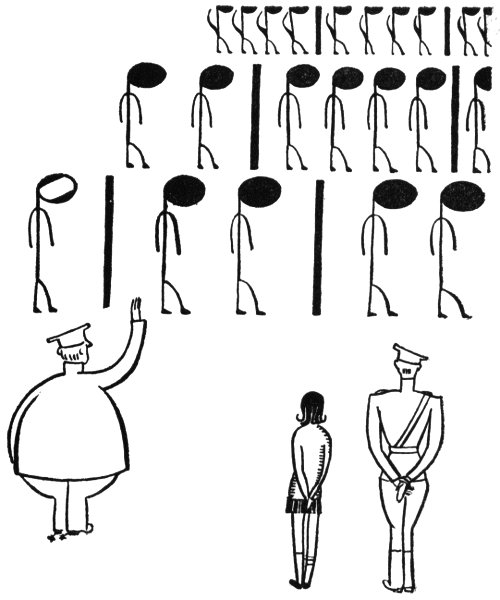
BETWEEN THE BARS
As Alice, accompanied by the Colonel and the Major, left Headquarters she saw that a row of black posts had been set up in the middle of the Parade Ground. These posts were about six feet tall and stood some twelve feet apart. Beyond them, drawn up in line formation and standing at ease, was a company of notes of all denominations—whole notes, half notes, quarter notes, and so on, down to sixty-fourth notes with four tails. Standing in front of the company, talking to the First Sergeant, was Lieutenant Rhythm.
At the edge of the Parade Ground, almost directly in front of Headquarters, was a small reviewing stand composed of several tiers of wooden seats, rising one above the other.
“Let us sit here,” said the Colonel. “The seats are rather hard, but young people don’t mind that, and soldiers are used to it; and from here we shall have a good view of all that happens on the Parade Ground.”
“Aren’t we going back to the Great Staff?” Alice inquired.
“Not yet,” said the Colonel. “The Staff is not necessary for the rhythmic drill, since rhythm is quite independent of pitch; and it’s more convenient to hold the drill here on the Parade Ground. All we have to do is mark off distances to represent measures of musical time. That is easily done by setting up those black posts to take the place of bars.”
The Colonel was silent for a few moments, staring thoughtfully into the distance and drumming with his fingers on the railing of the stand. Then he said:
“I wonder if you know what ‘rhythm’ is?”
“Well,” said Alice, “I think I know, but I’m not sure that I could explain it.”
“I don’t suppose you could,” said the Colonel. “It isn’t easy to explain; but I shall try to explain it to you:
“Rhythm is regularity. In a broad sense, anything that is repeated over and over again, in exactly the same way each time, is a rhythm. The return of the seasons each year, the alternation of day and night, the ticking of a clock—all these things are rhythmic because they are regular. In music, rhythm means the regular repetition of an impulse which we call a ‘beat.’ When soldiers march, for instance, the fall of their feet, all together and with perfect regularity, makes a rhythmic sound. A galloping horse also makes a rhythmic sound; but the sound of several horses walking is not rhythmic, because the noises they make are irregular and are not repeated over and over again, always in the same order.
“Rhythm, however, is not something you hear or see, but something you feel. It is usually suggested to you by sounds, such as the hoofbeats of the galloping horse, or by regular movements, such as the swinging of a pendulum; but rhythm itself is something stronger and more mysterious than the sounds or visible motions that suggest it. Suppose you were watching soldiers march by, in a parade—the chances are that you would soon find yourself counting ‘One—two, one—two,’ in time with the sound of their footsteps.”
Alice nodded her head. “Yes,” she said, “I do that every time I see a parade. Somehow I just can’t help it.”
“That shows you have a sense of rhythm,” said the Colonel. “Now, then, while watching a parade, have you ever seen the soldiers change to double time?”
“What is that?” Alice asked.
“Double time is the military term for a sort of jog trot, in which you take twice as many steps in the same length of time as you do in a march.”
“Oh, yes,” said Alice, “I’ve seen them do it in parades when they got left behind and wanted to catch up with the others.”
“Well, then,” said the Colonel, “when the soldiers changed to double time didn’t you find that the ‘one—two’ rhythm was so firmly fixed in your mind that you went on counting ‘one—two,’ even though you heard two footsteps to each count?”
“Yes,” said Alice; “only, when they changed to double time I counted ‘One—and—two—and, One—and—two—and——’ ”
“Which was an excellent idea,” the Colonel approved. “In that way you kept track of the parts of beats as well as of the beats themselves. Now we come to the next important point about rhythm, which is ‘accent.’ Have you ever noticed that one of your shoes generally wears out sooner than the other?”
“Why, yes,” said Alice, “and I’ve often wondered why.”
“It’s because you tread more heavily on one foot than on the other. Everybody does. Consequently, when you walk at a regular pace, one foot comes down a little harder than the other, which makes a stress, or accent, in the rhythm—‘One—two, one—two.’ All rhythms are like that: the first beat is heavier than the other, or others. In music we call the first beat the ‘strong’ beat and the others the ‘weak’ beats.
“Now, in reading music it is convenient to have the rhythms separated from each other in a way that the eye can easily grasp. For that purpose we use ‘bars,’ which are lines drawn vertically across the staff. The space between these bars are called ‘measures,’ and each measure contains exactly one rhythmic unit. By the way, you may sometimes hear the space between two bars referred to as a ‘bar.’ People have a way of saying ‘Three beats in a bar,’ or ‘Two bars’ rest,’ simply because ‘bar’ is a shorter word than ‘measure’; but that often leads to misunderstanding, and I hope you will never do it.”
Alice promised that she would be careful not to confuse the two terms, and the Colonel continued:
“A musical measure, then, contains one rhythmic unit—that is, the exact number of beats of which the rhythm is composed; and, so long as the same rhythm continues, all the measures are of equal length in time. The space a measure occupies on the printed page may be longer or shorter, according to the number of notes it has to accommodate, but the length of time it represents will be the same, whether it contains one note or many.
“Notes, you know, are the signs that indicate
the duration of musical sounds. The standard
note is the whole note, or semibreve. It represents
four beats and is equal to two half notes, or
minims; four quarter notes, or crotchets; eight
eighth notes, or quavers, and so forth. Any one
of these notes may represent a beat. In every piece
of music the kind of note that represents a beat,
as well as the number of beats that go to a measure,
is shown by the rhythm signature at the beginning
of the piece. This rhythm signature—which
is generally called ‘time signature,’ though
that is a misleading name for it—usually appears
as a fraction. The numerator, or upper figure of
the fraction, shows the number of beats that belong
in each measure, and the denominator, or
lower figure, shows the kind of note that constitutes
a beat. For example, the signature  means
that each measure contains four beats and that
each beat has the value of a quarter note.
means
that each measure contains four beats and that
each beat has the value of a quarter note.
“Theoretically, a measure may contain any number of beats, and, as I said before, any kind of note may represent a beat. However, you will seldom find measures that contain more than twelve beats, or beats of smaller value than sixteenth notes, and even those generally occur only in very slow music. Ordinarily, measures consist of two, three, or four beats, and the beats of half notes, quarter notes, or eighth notes. Measures of six eighths, nine eighths, and twelve eighths are compound rhythms and are generally counted as measures of two, three, or four beats, with a triplet of eighth notes to each beat.”
The Colonel glanced quizzically at Alice, who appeared slightly dazed.
“All this explanation is frightfully boring, isn’t it?”
“N—not exactly,” said Alice; “but it’s rather confusing. I’m afraid I’m not very good at figures.”
“Never mind,” the Colonel consoled her. “Almost everybody finds them hard at first. When you’ve seen the company perform the rhythmic drill it will all be much clearer to you—and you haven’t long to wait, for they’re about to begin.”
As the Colonel spoke, Lieutenant Rhythm,
having called the company to attention, walked
to the left-hand end of the row of black posts and
took up his position on the side nearer the reviewing
stand, looking down the row of posts. Standing
in this position he faced almost directly toward
Alice, who could see that the breast of his
tunic bore the sign  .
.
“The drill begins,” and the Colonel, “with two-four rhythm, which means that there are two beats to each measure and a quarter note to each beat. There they go!”
“Quarter notes—Forward—MARCH!” cried the Lieutenant.
A line of notes detached themselves from the company and marched forward. Two paces from the row of posts, at the command of the Lieutenant, they halted. The Lieutenant then gave the order: “By twos—between the bars—MARCH!” Instantly the notes separated into pairs, took two paces forward and halted, a pair of notes in each space between two of the posts.
“Left—FACE!” barked the Lieutenant, and the notes all turned to the left. As they did so they apparently vanished.
“Why!” exclaimed Alice, “they’ve disappeared. Where have they gone?”
“Nowhere,” said the Colonel. “They are still there, but they are so thin that you can’t see them unless they are facing you.”
“Poor things!” said Alice. “I never heard of such thin soldiers. Don’t they get enough to eat?”
“Oh, yes,” the Colonel assured her. “They are well fed, but we keep them thin on purpose, by giving them plenty of exercise. Their thinness is a great advantage, as you’ll see in a moment.”
Again the Lieutenant barked a command:
“Two-four rhythm—Tempo moderato—COUNT OFF!”
“One!” said the first note of the first pair. As he called out his number he faced to the right, suddenly becoming visible again, just as if he had materialized out of thin air. The second note then said, “Two!” and also faced to the right. Then the next pair took up the count, in perfect rhythm, followed by the third pair, and so on—“One—two”—all down the line. At each count a note reappeared at the proper place in his measure, so that when they had all finished counting Alice could see two quarter notes standing between each pair of posts.
“There,” said the Colonel, “you have a demonstration of the simplest form of duple rhythm—the rhythm of military marches, polkas, and many other kinds of lively music. However, music in two-four rhythm is seldom as simple as this—just one note to each beat. More often there are two or three or four, or even more, notes to some of the beats, and sometimes one note will last for two beats. The next part of the drill will show you how notes of different time value can be used in measures of two-four rhythm.”
As he spoke the quarter notes, at a word from the Lieutenant, about-faced and marched back to their place in the company line. Then the Lieutenant gave another command, and notes of various kinds marched forward and took their places between the posts. When the movement was completed Alice saw that each measure was occupied by a different kind and number of notes. In the first measure was a single half note; in the second, two quarter notes; in the third, four eighth notes; in the fourth, eight sixteenth notes. In the fifth measure were sixteen thirty-second notes, and in the sixth measure was a row of sixty-fourth notes so numerous that Alice hadn’t time to count them, but she guessed that there were thirty-two of them—which, she learned from the Colonel, was correct.
Again the notes faced to the left becoming invisible, and again the Lieutenant gave the command to “count off.” The half note in the first measure counted “ONE—two!” facing to the right at the first count. The quarter notes in the second measure called out their numbers and reappeared, one at each count, as they had done in the first part of the drill. Then came the eighth notes. As each of them represented only half a beat they had to reappear at double the rate of the quarter notes, or one to each half beat. This they did in the following manner: At the count of “one” the first eighth note appeared; then, midway between “one” and “two,” the second appeared, saying “and” as he turned. So they continued throughout the measure—“One—and—two—and,” one note appearing at each word, until all four were visible.
The sixteenth notes in the following measure counted off in a similar manner, except that they appeared at double the rate of the eighth notes, the first note saying “One,” the next three saying “and,” and so on—“One—and—and—and, two—and—and—and.”
The thirty-second notes counted and faced to the right twice as rapidly as the sixteenth notes, which was very fast indeed; but when it came the turn of the sixty-fourth notes to count off they spun around into view with such rapidity that it made Alice dizzy to watch them.
“Goodness gracious!” she cried. “How do they ever turn so quickly—and each one at exactly the right instant! Why, I can’t even count as fast as that.”
“They’ve been doing it for a long time,” said the Colonel, “and practice makes perfect, you know. Now they’re going to give us a demonstration of triple rhythm.”
Once more the notes which had just completed
their drill rejoined the company, and once more
the Lieutenant ordered out a fresh detachment of
various kinds of notes. The rhythm signature on
the Lieutenant’s breast was now  , and at the
command to “count off,” the notes in each measure
counted up to three. When they had finished,
the first measure contained three quarter notes;
the second, six eighth notes; the third, twelve
sixteenth notes; the fourth, twenty-four thirty-second
notes; and the last, forty-eight sixty-fourth
notes.
, and at the
command to “count off,” the notes in each measure
counted up to three. When they had finished,
the first measure contained three quarter notes;
the second, six eighth notes; the third, twelve
sixteenth notes; the fourth, twenty-four thirty-second
notes; and the last, forty-eight sixty-fourth
notes.
The drill now became more and more complicated. In the next exercise, which was in four-four rhythm, the first measure was occupied by a whole note. At the count of “one,” instead of facing to the right, as all the others had done, he remained invisible, but held up, so that it could be seen from the reviewing stand, a small black sign, oblong in shape and suspended from a short black rod. This, the Colonel explained, was a whole note rest.
“A measure, you know, must have its full quota of beats,” said the Colonel, “no matter how many notes it contains. Therefore rests are used to take the place of any note or notes that may be missing. Now, in the second measure we have, first, a half note. He represents two beats. Then there’s a quarter note, representing the third beat. That leaves one beat to be accounted for. It might be represented by another quarter note, by two eighth notes, by four sixteenth notes, by a quarter note rest, or by a combination of notes and rests. In this case, as you see, the last beat is represented by an eighth note, a sixteenth note, and a sixteenth note rest. The sixteenth note rest, you notice, like the note it stands for, has two tails, but it has no head, and the same is true of all the rests, from eighth note rests on down.
“The next measure,” the Colonel continued, “presents a novel feature. Its first note is a quarter, but he is holding up in his left hand a round black disk. That disk is called a ‘dot,’ and it increases the value of the note to the left of it by half. Thus the quarter note with the dot represents a beat and a half, and he and the eighth note which follows him fill up the first two beats of the measure, the other two beats being represented by a half note rest.”
In the next three exercises, which were in six-eight, nine-eight, and twelve-eight rhythm, the dot appeared very often; for, as each beat equalled three eighth notes, a quarter note had to be provided with a dot in order to represent a whole beat. Each of these drills was performed twice, the first time in slow tempo, the second time in fast tempo. In the slow six-eight drill each note had a number to himself, the count being “One—two—three—four—five—six”; but in the fast tempo only the first and fourth notes had numbers, the others saying “and” as they turned, so that the count was “One-and-and, two-and-and.” The nine-eight and twelve-eight drills followed the same system, except that their measures contained nine and twelve eighth notes, respectively.
When these exercises were finished and the notes were all back again in the company formation the Lieutenant gave the command “Rest,” whereupon the notes relaxed their rigid attitude of attention and began to chat and laugh together. Seeing that there was to be a moment’s intermission, Alice seized the opportunity to ask a question that had occurred to her.
“I’ve seen measures of two beats and three beats and four beats and six beats,” she said, “but I haven’t seen any measures of five beats. Aren’t there any measures that have five beats?”
“Yes,” replied the Colonel, “there are; but they are not used nearly so often as the others. Recently the General has begun to use measures of five beats more frequently, and occasionally he even uses measures of seven beats. But those rhythms are so difficult to follow that, if I were you, I shouldn’t try to learn them until I had thoroughly mastered the simpler ones. Now, after the notes have rested for a little while, they will give us a very interesting demonstration—an exercise in syncopation.”
“What is that?” Alice inquired.
“It’s the result of a conflict of accents.”
Alice looked blank, and the Colonel smiled.
“That isn’t a very clear explanation, is it?” he said. “Well, I’ll try to make it clearer. In music there are two kinds of accents—the rhythmic accent, which is the stress you feel on the strong beat of a rhythm, and the dynamic accent, which is the stress you hear when one tone is sung or played more loudly than another. As a rule, the rhythmic accent and the dynamic accent come together. Take, for example, the song ‘Yankee Doodle.’ If you recite the words without the music you will find that you naturally pronounce certain syllables more strongly than others—thus:
“ ‘YANK-ee Doo-dle CAME to town,
RI-ding on a PO-ny.’
“Now if you sing both the words and the tune, beating time as a conductor does while you sing, you will find that you naturally give a strong down beat as you sing the syllable ‘YANK,’ and a light up beat as you sing ‘Doo’; then another down beat at ‘CAME,’ and another up beat at ‘town,’ and so on. In such a case the two accents—the one you feel and the one you hear—come at the same instant. But sometimes the accent you hear comes on the weak beat instead of the strong one, which causes a conflict between it and the accent you feel. They fight each other, so to speak, to determine which is the more important. That is rather exciting, as fights usually are—which probably accounts for the fact that syncopation is always fascinating and explains why it is used so much in the popular dance music called ‘Jazz.’ And now we are going to see the notes represent syncopated rhythms.”
The Lieutenant called the company to attention and ordered out a detachment of eighth notes, who took their places in the measures by groups of four. The fourth note in each measure, Alice noticed, held in his left hand a curved black object that looked somewhat like the blade of a cavalry sabre. She asked the Colonel what this object was, and he told her it was called a “tie.”
“You will soon see what it is used for,” he added. “Meanwhile, I want to call your attention to the rhythm signature on the Lieutenant’s breast.”
Alice saw that it had changed back again
to  .
.
“That,” said the Colonel, “is the rhythm of the song we were just discussing—‘Yankee Doodle.’ Now watch carefully and you’ll see what happens when that rhythm is syncopated.”
At the command “Left—face” the notes disappeared as before, and at the command “Count off” they began to reappear, one by one, as they counted “One—and—two—and.” But as the fourth note faced to the right he called out his word, “AND,” very loudly, at the same time raising his “tie” and holding it so that one end was just above his head, while the other end extended over the bar into the next measure. The first note in the next measure then appeared, his head just beneath the other end of the “tie,” but he did not call out his number as he turned. The second, third, and fourth notes in this measure counted off in the usual way, the fourth note repeating the action of the fourth note in the first measure. The first note in the third measure remained silent as he appeared, just as the first note in the second measure had done, and this procedure was continued in measure after measure, until the end of the line was reached. It caused a curious halting effect in the rhythm, which Alice found very pleasant. She began to beat time with her hand, making a downward motion at “one” and an upward motion at “two,” and at the same time she counted in unison with the notes:
“One-and-two-AND—and-two-AND—and-two-AND”—and so on.
The Colonel nodded his head approvingly.
“You’ve got the hang of it,” he said. “I’m glad to see that you have a good sense of rhythm. Rhythm is in some respects the most important element in music, and a sense of rhythm is almost impossible to acquire if one happens to be born without it. Fortunately, Nature has endowed you with a strong rhythmic sense. Now I’ll show you how ‘Yankee Doodle’ sounds when sung in syncopated rhythm. Oh, Lieutenant!” he called, “be kind enough to repeat that exercise.”
The Lieutenant saluted and gave the necessary orders to the notes. As they began to count off again the Colonel sang, in exact time with their count:
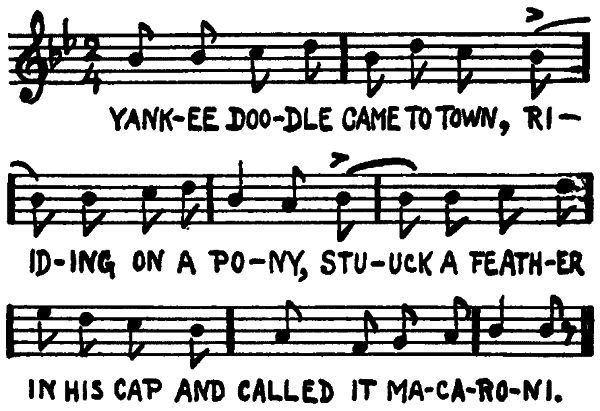
Alice laughed. “That does sound funny!” she exclaimed. “But I like it.”
“Of course,” said the Colonel. “Everybody with a good sense of rhythm likes syncopation. It’s rather like solving a puzzle—it exercises the mind.
“And now you’ve seen enough of the rhythmic drill, at least for to-day. The next thing on the program is the harmonic drill, and for that we must return to the Great Staff.”
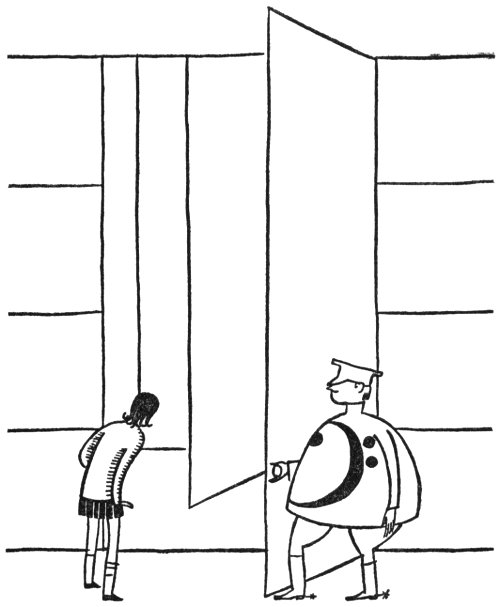
ALICE TAKES COMMAND
“How do we get back to the Great Staff?” Alice inquired, as she and the Colonel and Major Bass Clef left the reviewing stand. “Do we have to climb all those dark steps?”
“No,” said the Colonel, “there’s a much easier way. We merely have to turn back a few pages. Come along and I’ll show you how it’s done.”
They walked away from the Parade Ground, past Headquarters and the Officers’ Club, until they came to a high white wall which Alice had not noticed before. In the wall was an enormous door, all covered with printed words, exactly like a page out of a book. Alice thought this rather queer, and as she drew nearer she looked carefully to see what was printed on the door. To her astonishment the first word she saw was her own name; and her astonishment increased as she read further for there before her eyes were the very words she had spoken just before leaving the reviewing stand:
“Alice laughed. ‘That does sound funny!’ she exclaimed. ‘But I like it.’ ”
And then followed what the Colonel had said about everybody liking syncopation.
Alice stared at the printing on the door as if it were a ghost. In fact, it was rather like a ghost—the ghost of her conversation with the Colonel. It was uncanny. She turned, bewildered, to the Colonel.
“How,” she began—“why—I mean what——” She stopped, too confused even to frame a question.
“Hullo!” said the Colonel, “what’s the matter?”
Alice pointed mutely at the door.
“Well,” said the Colonel, “what’s wrong with it?”
Alice found her tongue again.
“Do you see what’s printed on it?”
“Certainly,” said the Colonel. “The print is quite clear.”
“B-but,” Alice stammered, “don’t you see what it says? Those are the very words we were saying only a moment ago.”
“Exactly,” the Colonel agreed; “but that’s nothing to be excited about. What you see is merely the end of the last chapter before this one. I told you that we were going to turn back a few pages.”
“Yes,” said Alice, still bewildered, “but I don’t understand. I can see that this door is a page—but what is it a page of?”
“Of this story.”
“What story?”
The Colonel smiled at Alice’s perplexity.
“The story of you and me and our friend the Major—and of all you have seen and done to-day.”
For a moment Alice considered what the Colonel had said; then her eyes flashed and she demanded aggressively:
“Do you mean to say that we are only characters in a story?—because if you do, you’re mistaken. I don’t know about you, but I’m a real person.”
“Well,” said the Colonel, “I hope we’re all real, even if we are characters in a story. In any case, we haven’t time to argue about it now. We must get back to the Great Staff.”
Alice was not at all disposed to let the matter rest there. She resented the insinuation that she was only a story-book person. Why, it was ridiculous! She could see and hear and feel and think. She knew she was real. However, she had no opportunity to continue the discussion, for the Colonel grasped a knob at the left-hand side of the door and swung the door back on its hinges, revealing another door covered with printing. Before Alice could see what was printed on this second door the Colonel had opened it also, disclosing a third. After the third door came another, and after that still more, until Alice lost count. Eventually, however, they came to the last door, and as this one swung open Alice found herself once more at the bottom of the Great Staff.
“There!” exclaimed the Colonel. “That was better than groping along a dark passage and stumbling up a lot of steps, wasn’t it?”
“Much better,” Alice agreed.
“Besides,” the Colonel added, “it saves time. We should have been late if we had come the other way, for there comes Captain Key now, with the company which is to perform the harmonic drill.”
The notes, in column of squads, with Captain Key Signature at their head, came marching along at the bottom of the Staff. As they drew near the spot where Alice and her companions were standing the Captain cried “Comp’ny—’Ten-SHUN!” and all the notes threw their chests out and their heads back and kept their eyes rigidly to the front. When the head of the column was opposite the Colonel the Captain saluted and the Colonel returned the salute. Then, when half of the column had passed by, the Captain commanded, “Squads left—MARCH!” whereupon each squad pivoted to the left, swinging into line with the other squads. As they completed this movement the Captain cried, “Comp’ny—HALT!”—and there stood the notes, drawn up in two long ranks, facing the Staff.
“At ease!” said the Captain, and the notes relaxed their rigid pose. The Captain came forward and again saluted the Colonel.
“Are you ready, sir?” he inquired.
“Quite ready, Captain,” said the Colonel. “I suppose you are going to begin with the intervals, as usual?”
“Unless you prefer that we change the routine,” said the Captain.
“No,” said the Colonel. “Follow the usual procedure, by all means—only, you may omit the more complicated details, as I merely wish to give our guest a general idea of the subject. By the way, where is Major Treble Clef? You can’t begin without him.”
“Something must have detained him,” said the Captain, glancing at his watch. “I’ve never known him to be late before. Ah, here he comes now!”
The Treble Clef hurried up to the group and saluted the Colonel.
“Sorry I’m late, sir,” he panted. “Had to look after a note who got hurt while on fatigue duty. One of those rookie semiquavers. Awkward lot, those rookies. Wonder they don’t all get their heads knocked off.”
“Was he badly injured?” the Colonel inquired.
“Not seriously. A bar fell on him and broke one of his tails. He’ll be all right. I sent him to the Post Infirmary. They’ll patch him up and have him back on duty before he realizes what happened to him. And now I suppose you are waiting for us to get to work.”
“If you’re quite ready,” said the Colonel. “You seem a trifle out of breath.”
“Oh, that’s all right, sir,” said the Treble Clef, and he took his place on the second Line of the upper Staff—for the Great Staff had been again divided into two Staves by the removal of the middle Line. As the Treble Clef reached his post Captain Key turned toward the company and cried:
“Whole notes—Form intervals—Unison to octave—MARCH!”
Two squads of whole notes sprang from the ranks, ran up the steps and took up positions on the treble Staff. Eight of them stood in a row on Middle C, the first leger-Line below the Staff, while the other eight formed a scale extending from Middle C up to the C in the third Space of the Staff. The first note of the second eight stood close beside his comrade of the lower eight, sharing the same leger-step with him, while the others placed themselves so that each of them was directly above the corresponding note in the lower row.
“Hold it a moment, Captain,” said the Colonel. “I must explain this formation to our young friend. There,” he went on, turning to Alice, “we have eight intervals of the diatonic major scale, which means the major scale in its natural state, with none of its steps altered by accidentals. The first interval is called a ‘Unison,’ because the two notes stand together on the same step. The next interval is called a ‘Second,’ because it includes two steps, and the others are named in the same way, according to the number of steps they include. The interval containing three steps is a ‘Third,’ the one containing four steps is a ‘Fourth,’ and so on, up to the last interval, which contains eight steps and is called an ‘Octave.’
“Now, intervals are divided into two classes—Major and Perfect. Seconds, Thirds, Sixths, and Sevenths belong to the Major class, while Unisons, Fourths, Fifths, and Octaves belong to the Perfect class. Intervals, however, are not always either Major or Perfect. If you make a Major interval a half-step smaller it becomes Minor. Take, for example, the Major Second you see there: the notes that represent it are on C and D, which are a whole step apart; but if the lower note were on C-sharp, or the upper on D-flat, the interval would be a half step smaller and would be called a Minor Second. Just a moment and I’ll have the Captain illustrate the point.”
The Colonel spoke a few words to the Captain, who turned toward the company and shouted “Orderly!” Instantly the little soldier with the Sharp on the front of his tunic and the Flat on his back sprang forward and saluted. At his side hung a large, flat leather case, suspended by a strap over his shoulder.
“Lower D in the second interval,” said the Captain; and the orderly, taking a Flat from the case at his side, ran up the steps and placed the sign at the left of the note on D. As he did so the step on which the note stood sank down to half its former height.
“There,” said the Colonel. “That shows you how a Major Second can be changed into a Minor Second. The other Major intervals can be changed into Minor intervals in the same way; and some of the Minor intervals, particularly the Minor Seventh, can also be reduced by a half step, in which case they are called ‘Diminished.’
“Major intervals can also be increased in size. When they are made a half step larger they are said to be ‘Augmented.’ Captain, show us how our Second can become Augmented.”
The Captain spoke to the orderly, who removed the Flat he had placed beside the note on D. The step promptly rose to its original height; and then, as the orderly placed a Sharp where the Flat had been, the step continued to rise until it was half as high again, which left a space equal to three half steps between the C and the D-sharp.
“Thank you, Captain,” said the Colonel, “that will do.”
“As you were!” cried the Captain, and the orderly removed the Sharp, the step sinking again to its normal position.
“Perfect intervals,” the Colonel resumed, “may also become Augmented or Diminished, as they are increased or reduced in size; but they can never become Major or Minor. Is that clear?”
“Yes,” said Alice, “I think I understand; but how can I tell whether an interval is Major or Minor, or Augmented or Diminished?”
“You will learn, in course of time, to distinguish them by the way they sound,” said the Colonel; “but in the meanwhile you had better learn them by the number of half steps they contain. In any good textbook on musical theory you will find a table showing the number of half steps in each interval. We can’t stop to learn the table now, as it would take too long, but you can look it up when you get home. Now we must get on with the drill. Captain, you may proceed with the next exercise.”
At the Captain’s direction the notes changed their positions on the Staff, and the Colonel went on to explain the new arrangement.
“This,” he said, “is the first exercise in chord formation.
“An interval, as you’ve just seen, is composed of two notes, but a chord must contain at least three. To construct a chord, we place a note on any step we please—in this case the Captain has placed his first note on Middle C—which constitutes the ‘root’ of the chord. Then we place another note on the step a Third above, and still another on the step a Fifth above the root. Thus we have the chord C—E—G. Such a chord of three notes is called a ‘Triad.’ Now, I want you to notice particularly that chords are constructed by adding notes above a root at intervals of a Third. In this Triad, C—E—G, E is a Third above C, and G is a Third above E. If any other interval appears between the notes of a chord, the chord is said to be ‘inverted.’ That means that the root, the step from which the chord takes its name, is given to one of the upper notes instead of to the lowest, which is called the ‘bass.’ Look—the Captain is going to invert the Triad.”
“First inversion—MARCH!” cried the Captain.
The lowest of the three notes forming the Triad left his place on Middle C, ran up to the third Space of the Staff and halted, directly above the other two notes.
“Now,” said the Colonel, “we have the chord E—G—C. It is still the chord of C, but it’s no longer a Triad, because it’s no longer composed of a series of Thirds. This chord is called a ‘Chord of the Sixth,’ because the highest note is a Sixth above the bass note instead of a Fifth. All right, Captain—go ahead.”
“Second inversion—MARCH!” cried the Captain.
The note on E left his place and ran up the steps, halting at the fourth Space of the Staff.
“The chord,” said the Colonel, “is now in its second inversion, and is called ‘Chord of the Fourth and Sixth’—or, sometimes, ‘Six-Four Chord’—because those are the intervals formed by the notes G—C—E.
“Now let’s find out whether you’ve understood all this. I shall ask the Captain to form another chord, in one of its inversions, and then I want you to tell me which note is on the root step of the chord.”
The Captain gave an order, and the three notes took up new positions on the Staff. The lowest one now occupied the first Space, the second one the second Space, and the third one the fourth Line, forming the chord F—A—D.
“Well,” said the Colonel, “which is the root?”
“Oh, dear!” Alice exclaimed, “I’m afraid I don’t know how to——”
“All right,” the Colonel broke in, “I’ll tell you how to find the root of an inverted chord. All you have to do is to keep on inverting it until it appears again as a series of Thirds. Then the lowest note is the root. Suppose you take command of the notes yourself and show us whether you can restore the chord to its root position.”
Alice hesitated. She was thrilled by the idea of commanding the notes, but she was not sure that she would know how to go about it.
“Do you think they’d do what I want them to?” she asked. “I don’t know how to give commands.”
“It won’t matter if your commands are not in proper musitary language,” the Colonel assured her. “Tell them what to do in any words you please—they’ll understand.”
Still Alice hesitated.
“Would they mind if I led them by the hand?” she inquired timidly. “I think I could show them what to do better than I could tell them.”
“Very well,” said the Colonel, “you may lead them if you prefer. It’s not the way they’re accustomed to being commanded, but I think they’ll obey—won’t you, boys?”
The notes grinned, and Alice, encouraged, went up to the lowest one and grasped his hand.
“I hope you don’t mind,” she said, as she led the note up the steps.
“No, indeed, miss,” said the note. “Orders is orders—and you’re the C. O., accordin’ to the Colonel.”
Halfway up the Staff Alice paused uncertainly.
“Now, where is it you are supposed to go?” she asked, speaking more to herself than to the note. “I know you are supposed to go up—but how far?”
“Eight steps, ma’am,” the note prompted in a husky whisper. “I mean, to the eighth step above the one I was on. I always go up an Octave when I’m inverted.”
“Oh, of course!” said Alice. “I remember noticing that the first time you did it. Then you went from Middle C to the C in the third Space. This time you were in the first Space, which is F. That means you must go to the next F above, which is the top Line. That’s right, isn’t it?”
“Quite right, ma’am,” said the note.
“Come along, then,” and Alice conducted the note to the topmost black step, where she carefully placed him in line with the two notes lower down.
“Very good,” the Colonel commented. “Now come down here and have a look at your chord.”
Alice ran down to where the Colonel was standing, below the Staff, and surveyed the three notes.
“What steps are they on now?” the Colonel demanded.
“The lowest one’s on A,” said Alice, “the next one’s on D, and the highest one’s on F.”
“Right. What is the first interval—A to D?”
Alice counted the steps. “A Fourth,” she declared.
“Right again,” said the Colonel. “That proves that your chord is not yet in its root position, for there is no Fourth in a Triad. Now, I wonder whether you can tell me what chord that is?”
Alice considered carefully. “A to D is a Fourth,” she said to herself, “and A to F is a Sixth. Why,” she announced confidently, “it’s a Chord of the Fourth and Sixth.”
“Excellent!” cried the Colonel. “You’re coming along splendidly. Now go ahead and turn your chord into a Triad.”
Alice was sure now that she knew what to do. Running up the steps again, she took the hand of the note on A and led him to the top of the Staff. There, however, she was obliged to halt again in uncertainty.
“What are we going to do now?” she asked the note. “We’ve only come up six steps, and there aren’t any more.”
“You’ve gotta have leger-steps, miss,” the note whispered. “Just put your foot on that button there at the edge of the top step—no, not that one—the second one, marked A.”
Alice pressed the button indicated by the note, and instantly two short steps, one white and the other black, rose noiselessly into position from underneath the top step of the Staff.
“My!” Alice exclaimed admiringly, “that’s a clever arrangement. Now, you go and stand on the top little step. I’ve got to go downstairs again.”
The note did as he was told, and Alice ran down to the bottom.
“Well?” the Colonel inquired, as she examined the result of her efforts. “What have you got now?”
Alice stared at the notes for a moment with her brow puckered. “D—F, that’s a Third,” she said to herself, “and F—A is another Third.” The puckers disappeared from her brow and she said to the Colonel: “It’s a Triad.”
“It is,” the Colonel confirmed. “Your chord is now in its root position, because the root—D—is given to the lowest note. Now, there’s just one thing more I want to show you regarding Triads. Captain, just have your notes take the same chord in open position, if you don’t mind.”
“Certainly, sir,” said the Captain, and he commanded the notes to take new positions. When they had done so the lowest note stood on a white leger-step just below the treble Staff, the next one in the second Space, and the highest on the top Line.
“What chord have we now?” asked the Colonel.
Alice studied the group of notes. “The bottom note is on D,” she said, “the next is on A—that’s a Fifth higher—and the top one is on F. That’s—why, that’s a Tenth above D!” She shook her head slowly. “I don’t know that chord,” she confessed.
“You do know it,” said the Colonel, “but you don’t recognize it in that position. Suppose you bring the top note down an octave, to the F between the D and the A. What chord will you have then?”
“The Triad of D,” Alice replied promptly.
“And that’s the chord you have now. You see, inversion of the upper notes doesn’t change the chord. So long as the lowest note is on D and the upper ones are on A and F the chord remains a Triad of D, no matter how far apart the notes may be; and the same rule applies to the inversions. If the Third of the chord is given to the lowest note it is a Chord of the Sixth; and if the Fifth is given to the lowest note it is a Chord of the Fourth and Sixth, regardless of how the upper notes are spaced.”
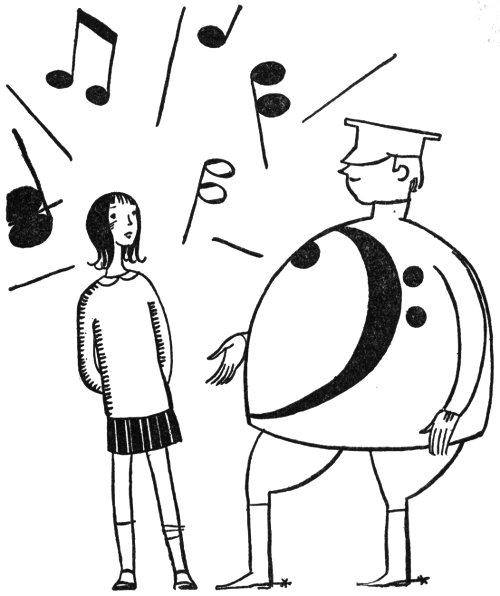
GUIDEPOSTS
Alice nodded her head thoughtfully. “The chords are not so hard to understand,” she said. “I thought it would be much harder to learn all about them.”
“Oho!” said the Colonel, “you haven’t learned about all of them yet—not by any means. The only chords you’ve seen thus far are the Triads and their two inversions. We haven’t even shown you a Chord of the Seventh, which is one of the most important chords we have. However, the Captain is just about to construct one for us. He has already placed three notes so that they form a Triad on G. Now watch what happens.”
The Captain shouted a command, and a single whole note advanced from the ranks, mounted the steps, and halted on the top Line, immediately above the other three.
“There,” said the Colonel, “the chord now consists of four notes—G, B, D, and F—arranged in a series of Thirds. It is a Chord of the Seventh, so called because it contains an interval of a Seventh in addition to the intervals of the Triad. If we added another note a Third higher than the F the chord would be a Chord of the Ninth, and in the same way we could build up chords of the Eleventh and Thirteenth, simply by adding more notes at intervals of a Third.
“Now, as every chord has an inversion for each of its notes above the root, you can see that there are many tone combinations with which you are not yet familiar. However, we shall not take the time to show them all to you now. You understand, I’m sure, how they’re constructed, which is all that’s necessary for the present.
“But let’s have another look at that Chord of the Seventh. Its root is G, which, in the key of C, is the Dominant. Do you know what ‘Dominant’ means?”
Alice shook her head.
“Well,” said the Colonel, “there are three ways of designating the degrees, or steps, of the scale. They can be designated by numbers—1, 2, 3, 4, 5, 6, and 7; by letters—A, B, C, D, E, F, and G; or by names—Tonic, Supertonic, Mediant, Subdominant, Dominant, Submediant, and Leading Tone. All three ways are useful, but the most useful are the numbers and the names, because they remain the same in all keys—that is, the first degree of the scale is always the Tonic, the second degree is always the Supertonic, and so on, no matter what key the scale is in; whereas C is the first degree, or Tonic, only in the key of C. In the key of F, C is the fifth degree, or Dominant, and in the key of G it is the fourth degree, or Subdominant.
“The fifth degree of a scale is called the Dominant because it is the most important degree except the Tonic; and a chord that has the Dominant for its root is called a Dominant chord. This Chord of the Seventh which the Captain has constructed for us has G for its root, and since the key is C—the Captain, you notice, has neither Sharps nor Flats on his breast—G is the Dominant of the scale. Therefore the chord is a Dominant Seventh, the most important chord except the Tonic Triad.”
“Why is it so important?” Alice demanded.
“Because of the part it plays in the Cadences,” replied the Colonel.
“That doesn’t seem to make it much clearer,” said Alice. “What are Cadences?”
“Cadences,” said the Colonel, “are the guideposts of music. They point the way and mark off distances in musitary campaigns. All of the General’s plans are based on them.”
“Oh, dear!” Alice exclaimed impatiently, “who is this general that everybody talks about? What does he look like?”
“Ah,” said the Colonel mysteriously, “one never knows until he appears.”
Alice frowned. The General was beginning to get on her nerves. It was annoying that everybody spoke of him so often and nobody would tell her any of the things she most wanted to know concerning him—his name, his appearance, where he lived, and why everybody seemed so much in awe of him. Her curiosity, however, was greater than her annoyance, and she begged the Colonel to describe his mysterious Commander in Chief, who, she was convinced, must be a very magnificent and impressive person. But the Colonel would give her no further information.
“You’ll have to wait,” he said, “until you see him.”
“But when will that be?” Alice persisted.
“I don’t know. One never knows when or where to expect him. He may come here to-day, and he may not turn up for goodness knows how long. You’ll have to trust to luck. In the meanwhile we must get on with the drill. You now know something about the construction of chords, but you haven’t learned how they are used to make a musical composition. We can’t go very deeply into that subject to-day, but I should like to give you a general idea of it.
“To begin with, chords are of two kinds—Concords and Discords. Concords are those which have a more or less satisfying and restful sound. The most satisfying Concord is the Tonic Triad. Almost all musical compositions end with the Tonic Triad, because it seems most complete and restful to the ear, and therefore a natural stopping place.
“Discords, on the other hand, have an unsatisfying and restless sound. They make you want to hear some other chord, to ‘take the taste out of your mouth,’ as you might say.”
“Goodness!” Alice exclaimed, “they must be very unpleasant. What good are they?”
“They make the Concords sound better by contrast, and, at the same time, they prevent you from getting too much of a good thing. Music, you know, is rather like a spice cake. It has sugar in it to make it sweet, and ginger—or something of the sort—to make it spicy. Concords are the sugar of music and Discords are the spice; and to make good music you must use just enough of each. Too many Concords will spoil your music just as surely as too much sugar will spoil a cake. Of course, too much spice will also spoil the cake; but when used with discretion it gives the cake a delightful flavor.
“Now, the reason Discords sound ‘spicy’ is that they contain one or more dissonant, or unrestful, intervals. The dissonant intervals are the Seconds and Sevenths and all augmented and diminished intervals. The others—major and minor Thirds and Sixths, and perfect Unisons, Fourths, Fifths, and Octaves—are all consonant, or ‘sweet’ intervals. The Dominant Triad, like the Tonic Triad, is a Concord, because it is composed entirely of consonant intervals; but the Dominant Seventh chord is a Discord, because it contains a Seventh, which is a dissonant interval. And this brings us to the subject of Cadences.
“There are several kinds of Cadences. When the last chord of a piece of music is the Tonic Triad—as it nearly always is—and the chord before it is a Dominant Triad or a Dominant Seventh, we have what is called an Authentic Final Cadence. Captain, will you kindly show us Cadence Number 1-a, in C major?”
The Captain saluted and proceeded to arrange his notes in the following manner, using both the bass and the treble staves:

“There,” said the Colonel, “you have an Authentic Final Cadence consisting of the Dominant Triad followed by the Tonic Triad. It is a very satisfactory way to end a composition; but there is another way that is still better. Captain, let us have Cadence Number 1-b.”
The Captain changed the position of a note in the first chord, so that the Cadence looked like this:
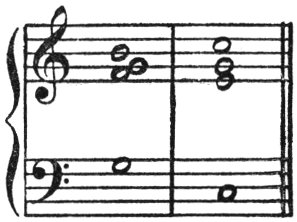
“That makes it much stronger,” said the Colonel, “for the first chord, being now a discord, makes the Tonic Triad which follows it sound even more restful and satisfying than before.”
“How can you tell what it sounds like?” Alice inquired, with a puzzled look in her eyes. “I don’t hear anything.”
“I can hear the chords in my mind,” the Colonel explained. “By long practice I have learned the sound of all intervals and chords, so that when I see the notes that represent them I know at once how they would sound if they were sung or played.”
Alice opened her eyes wide. “Why, that’s wonderful!” she exclaimed. “Do you s’pose I can ever learn to do that?”
“Certainly you can. Anyone who has a good ear for music can learn to hear it mentally; but very few try hard enough and long enough. You have to study Theory and Harmony, and particularly Solfeggio, or sight singing; you must begin while you are young, and, above all, you must stick to it.”
“I shall begin as soon as I get home,” Alice declared, “and I’ll work ever so hard. But I do wish I could hear those chords now.”
“Well,” said the Colonel, “since you haven’t yet learned to hear with your eyes we’ll see whether you can do better with your ears. Captain, let us hear the Cadence.”
“Sound off!” cried the Captain—and, to Alice’s surprise, each note sang the tone he represented in his chord, those in the Dominant Seventh singing first and the others beginning just as the first four left off.
“Why,” said Alice, “it sounds just like an organ! It’s beautiful—and now I know what you meant when you said that the Tonic Triad sounded restful. It’s as if you were all tucked up in bed and—and your mother said, ‘Good-night,’ and turned out the light.”
The Colonel smiled. “Yes,” he said, “that’s just about the way it makes you feel—as if the day’s work were ended and you were nice and comfy and ready for a good rest. Evidently you have feeling for music as well as a good ear. Stick to it—study it, practice it, learn all you can about it, and it will be one of the joys of your life. Now I’ll show you another kind of Final Cadence. Captain, Cadence Number 2, if you please.”
The Captain rearranged the notes, so that they appeared in this order:
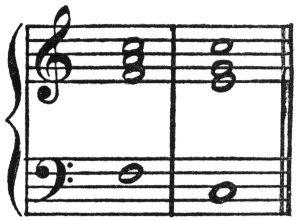
“That,” said the Colonel, “is called a Plagal Cadence. It is also a final Cadence, but it is not so strong as the Authentic one. However, it has a more dignified and solemn sound, and for that reason it is used chiefly in church music. It is the Cadence to which the Amen is sung at the end of hymns.
“Now we come to the middle Cadences—those which mark the ends of musical phrases, just as commas mark the ends of literary phrases. Music, you see, is a kind of language. It expresses both thoughts and feelings, just as words do. Of course, it can’t always express thoughts quite so clearly as words can express them, but it often expresses feelings far more strongly. For example, it is hardly possible to say in music that ‘Sunlight is a form of energy’—unless you set the words to music and sing them; but music can express, better, perhaps, than words, the happiness we feel on a sunny day, when the birds are singing and the flowers are blooming and everything is just as it ought to be. And—best of all—anybody with an ear for music will know what it means, for people of all nations can understand the language of music, whether their native tongue be English, French, German, or Czecho-Slovakian.
“Music, though, like any other language, must be clearly phrased. If a book were printed without any commas or semicolons or periods it would be difficult to make sense out of it; and if music were composed without any Cadences it would be equally hard to understand. Now, you’ve already seen and heard the Final Cadences, which are the musical periods, or full stops. The Cadences we shall show you next are the commas and semicolons. Captain, let us see Cadence Number 3-a.”
The Captain arranged his notes in the following order:
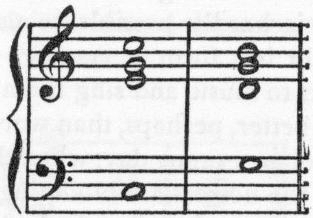
“This,” said the Colonel, “is called a Half-Cadence. Sometimes it represents a comma, sometimes a semicolon, and sometimes it takes the place of a question mark, for it sounds very much as if it were asking a question. Listen!”
The notes sang the Cadence, and Alice found that what the Colonel had said was quite true. The Colonel then called for Cadence Number 3-b:
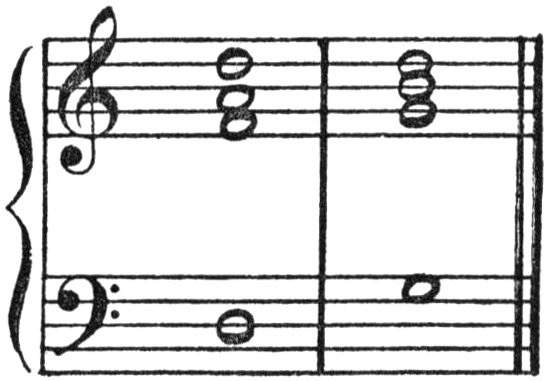
This, he explained, was another form of Half-Cadence, the difference being that here the Dominant chord was preceded by the Supertonic instead of the Tonic chord.
The next Cadence, Alice learned, was called “Deceptive Cadence,” because its second chord was not the one that the ear naturally expected.
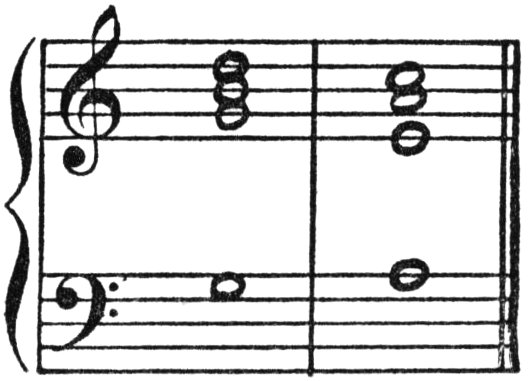
Then followed two Imperfect Cadences, which were like the Authentic Final Cadence except that in the second chord the highest note was not the Tonic.
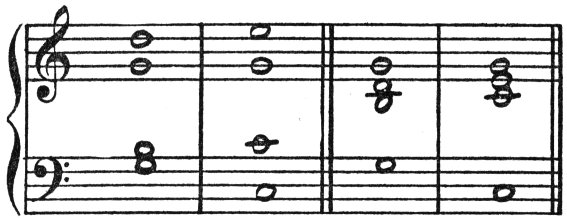
After the Imperfect Cadences had been sung by the notes the Colonel announced that the Harmonic Drill was ended.
“We’ve given you only a bare outline of it,” he said, “but you’ve seen enough to enable you to understand the Formal Drill, which is next on the program. The rest of the rules of Harmony you will learn from your textbooks when you get back to your own country. If you find any of them hard to understand come to see us again, and we’ll try to explain them to you. In the meanwhile, there’s just one thing more that I want to tell you about Cadences:
“A Cadence may end on either the strong or the weak beat. If the second chord falls on the strong beat of a measure the Cadence is ‘masculine’; if it falls on the weak beat the Cadence is ‘feminine.’ You will see—and hear—both kinds of Cadences later on. And now I must ask you to excuse me for a little while, as I must go and inspect the artillery.”
“Can’t I go with you?” Alice begged. “I should like so much to see those musical cannons!”
“You will see them in the Formal Drill,” the Colonel promised. “As it’s rather warm to-day I think you had better stay here with the majors and rest a bit in the shade.”
Alice looked at the Staff, which lay bathed in sunlight for miles and miles on either side. Then she turned and scanned the plain that stretched away from the bottom of the Staff to the horizon, without even a bush or shrub to cast a shadow.
“It would be nice to rest in the shade,” she sighed. “But I don’t see any shade.”
“You will in a moment,” said the Colonel; and, saluting Alice politely, he turned and disappeared into an opening in the Staff like the one through which Alice and the clefs had passed when they went to lunch.
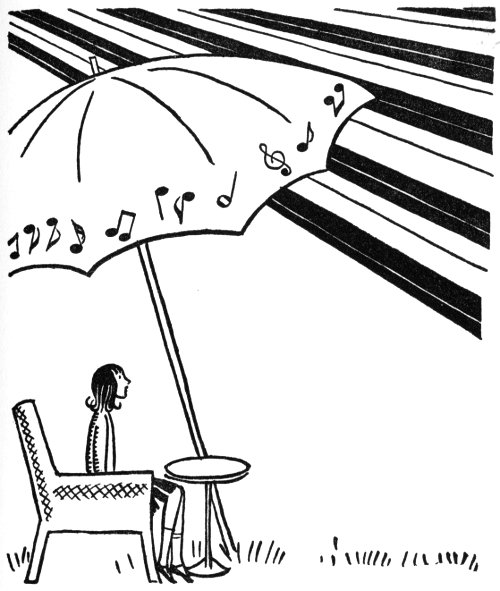
MUSICAL ARTILLERY
As Alice turned toward the plain once more, she saw a small group of notes, not far away, working energetically at some task the nature of which she was unable at first to determine. Presently, however, a huge white umbrella reared itself above their heads, and, as they finished their work and returned to their places in ranks, Alice saw that underneath the umbrella, looking very cool and inviting, was a white wicker chair with a little marble-top table beside it.
The Bass Clef, who, upon the Colonel’s departure, had resumed the rôle of host, conducted Alice toward the umbrella.
“Here’s the shade you were looking for,” he said. “Now let us decide what kind of refreshments we shall have. What would you like?”
“If you please,” said Alice, “I think I’ll have an ice.”
“A nice what?” inquired the Bass Clef.
“Why, an ice cream, of course—or a sherbet.”
The Bass Clef looked as if he had never heard of such things.
“I’m afraid,” he said dubiously, “that we haven’t anything of that sort. But if you want something cooling we can offer you a delightful composition by Ravel, called ‘Jeux d’Eau.’ You’ll find it very refreshing.”
Alice was a trifle disappointed. She hadn’t the least idea what the refreshment proposed by the Bass Clef might be, but she was sure that she would have preferred a pineapple sherbet. However, as pineapple sherbet appeared to be out of the question, she decided to accept the proffered substitute as gracefully as possible. Anyhow, she was rather curious to know what it was like.
“Do let’s have the—the——” Alice boggled at the name.
“ ‘Jeux d’Eau,’ ” prompted the Bass Clef.
Alice nodded. “That’s what I meant to say but I couldn’t quite—remember it. It’s a queer name, isn’t it?”
“Not if you know French,” said the Bass Clef. “It means ‘Water Games.’ ”
“Oh,” said Alice vaguely. “Well, anyhow, I’m sure it must be very nice.”
“It is, I assure you!” the Bass Clef exclaimed, with enthusiasm. “Now, you just sit here under the umbrella, and we’ll have it ready for you in a jiffy.”
Alice seated herself beside the little table, the Bass Clef having placed her chair so that it faced the Staff. For a moment nothing happened; then, at a word from Captain Key, the whole company of notes swarmed up the Staff and ranged themselves along its steps in an intricate but orderly pattern.
“That’s a good company,” the Bass Clef remarked approvingly. “Every note in it is a veteran. It’s a pleasure to see how quickly they find their places, isn’t it?”
“It’s wonderful,” Alice agreed. “But what are they doing?”
“Why,” said the Bass Clef, “they’re preparing the ‘Jeux d’Eau.’ ”
Alice looked surprised. “Dear me!” she said, “it must be a very complicated drink.”
“Drink!” cried the Bass Clef, “it isn’t a drink—it’s a piece of music. I supposed you knew that.”
“Oh, I’m sorry!” said Alice, blushing. “I thought you said it was a kind of refreshment.”
“So it is—refreshment for the ear. When you’ve heard it I think you’ll admit that music can be as refreshing as any drink. Now, if you’ll excuse me, Major Treble Clef and I will take our places so that you may hear the ‘Jeux d’Eau.’ ”
The two clefs took their posts, each at the head of his proper Staff, and Alice leaned back in her chair to listen. At the very first sounds, however, she leaned forward again, with an eager look in her eyes, for this music was unlike any she had ever heard before. The notes themselves were singing, as they had sung the Cadences, but their voices now had a strange liquid quality, as if each tone were a drop of clear, cool water.
Like jets from a fountain the sounds seemed to gush forth, poising high in the air for a moment, then separating into thousands of tiny individual drops which fell with tinkling splashes into the pool below. Now and then the drops would be caught in midair by the breeze and blown into iridescent spray, which floated away in a drifting rainbow, cooling the air and leaving little pearls of moisture on each flower and leaf and blade of grass. For the Staff and the notes had vanished, and where the black-and-white steps had been Alice now saw a lovely garden, surrounded by tall yew trees and filled with fragrant blossoms. In the middle of the garden was a lawn, green as emerald and smooth as velvet, and in the middle of the lawn was the fountain whose music rang so sweetly in Alice’s ear.
The water seemed to be in a merry, frolicsome mood. How it leaped and splashed and rippled, scattering diamonds that vanished in the twinkling of an eye! How it chattered and laughed and sang! No game was ever gayer or more varied. Each instant brought a different grouping of scintillating drops, a new combination of colors, a constant change of surprising and delightful harmonies.
Alice sat entranced. She felt deliciously cool and tranquil, and, at the same time, curiously thrilled. She knew that the garden with its fountain was merely an imaginary picture, inspired by the music she heard; yet the picture was so vivid that she could hardly believe it existed only in her mind’s eye.
“The Colonel may be able to hear with his eyes,” she thought, “but I can see with my ears—and I believe that’s just as good, if not better.”
She wished that the fountain might go on playing for the rest of the afternoon, but after what seemed a very short time the music ceased and the picture of the garden faded away.
Alice sank back in her chair with a sigh. She was sorry it was over; however, she felt so pleasantly rested and refreshed that she was quite ready for whatever might follow and was glad when she saw her friend the Colonel returning from his inspection of the artillery.
“Oh!” she cried, as the Colonel joined her under the umbrella, “I’ve just had the nicest refreshment! It was better than pineapple sherbet.”
“Splendid!” said the Colonel. “I thought you’d like it. And now, as you seem to be quite rested, we shall proceed with the Formal Drill.”
“What is the Formal Drill?” Alice inquired.
“A series of exercises in musitary tactics,” replied the Colonel. “It shows how a campaign is planned and carried out—or, as you civilians express it, how a piece of music is composed. When the general of an army leads his troops to war he must know in advance what he intends to do with them and, more or less definitely, how he is going to do it. He must decide where his forces are to go, by what roads they are to march, and what they are to do at various stages of the campaign.
“Now, a musician, when he sets out to compose a piece of music, must have a similar plan of campaign. In the first place, he must know how to handle his troops, which means that he must have mastered all the rules of Notation, Rhythm, and Harmony. Next, he must be familiar with the laws of musical tactics, which we call Musical Form, in order to know how to develop his musical ideas, or themes, into complete compositions. There are many forms of composition, you know, such as minuets, waltzes, rondos, sonatas, fugues, and so on; but every composition is made up of a number of parts, and it is the manner in which these parts are constructed and linked together that we are going to demonstrate now in the Formal Drill.”
By this time the notes had resumed their formation at the bottom of the Staff, and the Colonel, signifying to Captain Key that he was ready to begin the drill, took Alice by the arm and conducted her to a spot nearer the steps.
“Who is going to command the notes this time?” Alice asked.
“I am,” said the Colonel.
“But who will explain things to me and answer questions?”
“Don’t worry about that,” said the Colonel. “You see, as I have no post on the Staff, I direct the troops from here; so you can stand beside me and ask as many questions as you like.”
The Colonel paused and twirled his moustache for a moment, reflective. Then he said:
“Before we start the Formal Drill I think I’ll let you have a look at the artillery. I believe you said you were anxious to see it.”
“Do you mean the cannons?”
The Colonel nodded.
“Oh, yes!” cried Alice. “I do want to see them. Are they big ones?”
“Well,” said the Colonel, “we have canons of various sizes, but I think I had better show you one of the smaller ones. The big ones are so very complicated. Just a moment—I must prepare the emplacement; then I’ll show you a very pretty little canon that I’m sure you’ll find interesting.”
The Colonel called out a detachment of notes and ordered them to rearrange a section of the Great Staff into four ordinary five-Line Staves. When this had been done the notes placed themselves on the four Staves in accordance with the Colonel’s directions.
“There you are!” said the Colonel, when all had been arranged to his satisfaction. “That is a perfect little canon.”
“Where is it?” inquired Alice, who could see nothing resembling a piece of artillery.
“Right before your eyes,” said the Colonel.
“But I don’t see anything except the four Staves, with notes on them.”
“If you see that you see the canon. You remember, don’t you, that our canons are not the kind that shoot? Well then, this is a musical canon. You see, in music the word ‘canon’ means a kind of composition in which one voice, or part, exactly imitates another. That is, one voice begins a tune, and after it has sung a part of it—usually one measure or two—another voice begins the same tune, while the first voice goes right ahead, without waiting for the second to catch up. The trick, of course, is to keep both voices going, each singing the same tune but one trailing behind the other all the way, and yet making only agreeable harmonies.”
“Goodness!” Alice exclaimed, “I should think that would be hard to do.”
“It isn’t easy,” the Colonel admitted, “but the result is fascinating when it’s well done. The canon is one of the most interesting forms of composition, and it’s also one of the oldest. Long ago, when people first began to learn how to combine tones to form harmonies, they invented a system of writing one melody against another in such a way that when they were sung or played together they sounded well. That was called ‘counterpoint’; and the earliest example of first rate counterpoint that we know of is a canon for four voices called ‘Summer is icumen in,’ which was composed about the year 1200. Later, the great composers developed the canon into a very complicated form of music, the most elaborate variety of which is called a ‘fugue.’ The name comes from the Latin word ‘fuga,’ which means ‘flight,’ and it gives a very good idea of the way in which one voice seems to try to run away from the others while they try to overtake it.
“Now, the canon we have here is of the shortest and simplest kind, which is called a ‘round.’ It’s for four voices—and if the two Majors and the Captain will help me out we’ll let you hear how it sounds.”
The three officers said they would be happy to assist in the performance. They joined the Colonel at the bottom of the Staff, from which point they could see all the notes, and the Colonel began the round:
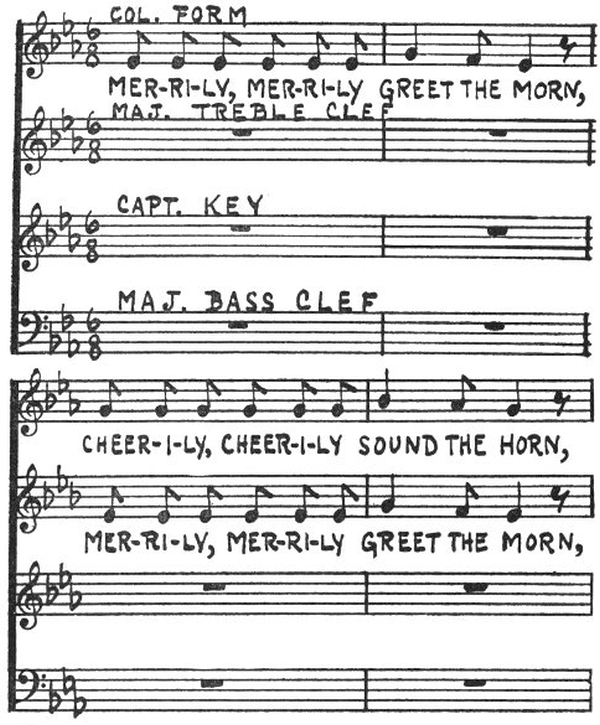
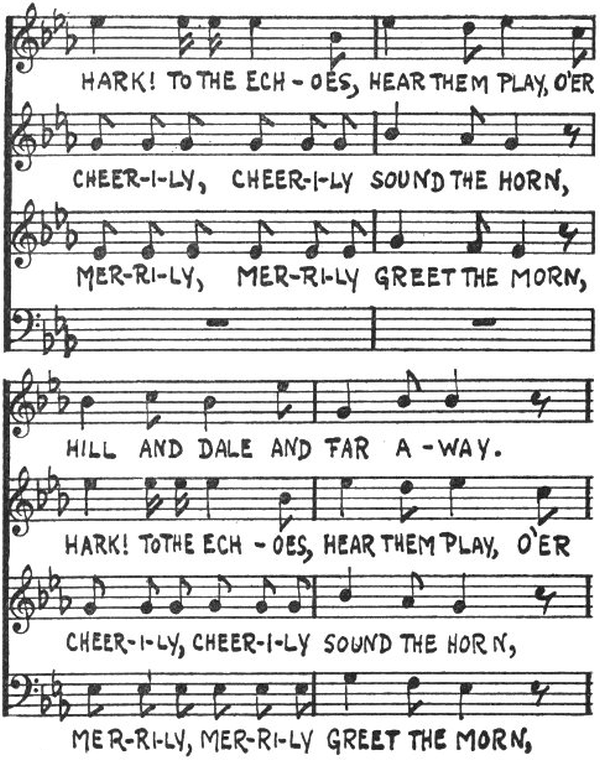
Alice was delighted, but she began to wonder how the round would ever finish, for each time the Colonel came to the end Major Treble Clef still had two measures left to sing, Captain Key was only half through, and Major Bass Clef had only just begun. This struck her as so funny that she began to laugh, whereupon the officers too began to laugh, and the round broke up in general merriment.
“That’s the way they usually end,” said the Colonel. “Of course, in the big canons and fugues the composer makes all of the parts end together; but a round simply goes on until everybody is out of breath.”
“It must be lots of fun to sing,” said Alice.
“It is indeed,” the Colonel assured her. “You must learn to sing this one—also ‘Three Blind Mice,’ ‘Scotland’s Burning,’ and a lot of others, equally amusing.”
“Do sing them for me now,” Alice begged.
“I’m afraid we haven’t time,” said the Colonel. “You’ll have to learn them for yourself when you get home. You can find them in various collections of popular songs published in your country. We must get on with the Formal Drill now. I’ll just have the notes replace the Staves as they were before—bass and treble—and then we’ll show you how the different parts of a musical composition are constructed and put together to form a complete piece.”
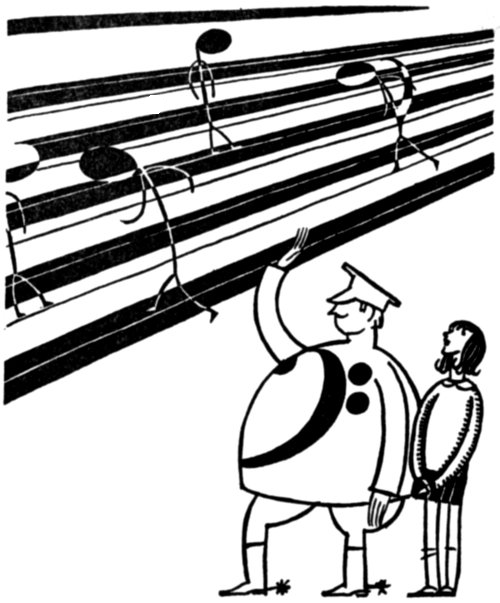
AN OLD ACQUAINTANCE
Once more Alice had cause to admire the energy and efficiency of the notes, for in an incredibly short time they had rearranged the Staves in accordance with the Colonel’s instructions and were ready to carry on.
“The Formal Drill,” said the Colonel, “begins with the formation of a Section, which is the smallest subdivision of a musical composition. It usually consists of two measures, or the equivalent of two measures—that is, it need not begin at the beginning of one measure and finish at the end of the second, but it must contain the number of beats required to complete two measures. Sometimes the Section is composed of one group of notes, sometimes of two or more. These groups of notes are called Motives. The Section I am going to show you is composed of a single Motive which just fills two measures.”
The Colonel ordered out a small detachment of notes, who ran up the steps and arranged themselves on the Staves in this manner:
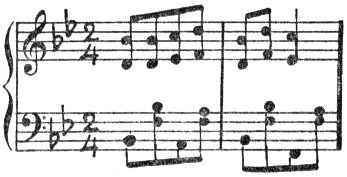
The Colonel surveyed the notes with an air of satisfaction. “There you have a Section that is simple but effective,” he remarked. “It has pleased millions of people.”
“Did you compose it?” Alice inquired.
“Oh, no,” said the Colonel. “Only generals can compose. I merely carry out their orders.”
“Who did compose it, then?”
“I’m afraid you have me there,” said the Colonel. “The tune is so old that nobody remembers who composed it—if anybody ever knew.”
“Then,” said Alice, “how do you remember where the notes belong?”
“Oh,” said the Colonel, “that’s quite another matter. Although nobody knows the name of the composer everybody knows the tune. I dare say you know it as well as I do.”
Alice stared curiously at the notes. “Well, maybe I do,” she said doubtfully, “but I don’t think——”
“You’ll recognize it presently,” the Colonel interrupted. “Now let’s get on with the drill.” Pointing to the notes on the Staves, he continued:
“If we add to this Section another Section of two measures, slightly different from the first and ending with a Cadence, we shall have a Phrase, which is the main element of a piece of music.”
The Colonel pondered silently for a moment; then he said:
“Perhaps all this will be clearer if we compare a piece of music to a bridge. You’ve seen many bridges and no doubt you’ve noticed that most of them consist of spans laid end to end, with their ends supported by piers.”
Alice nodded.
“Well, a piece of music consists of a series of Phrases, the ends of which are supported by Cadences. Now I shall complete our first span.”
The Colonel called out another detachment of notes, who grouped themselves on the Staves to the right of their comrades, so that the formation looked like this:

“You see,” said the Colonel, “the two chords in the fourth measure form a Half-Cadence, ending on the second or weak beat. That is the ‘feminine’ Cadence of which I told you. Do you recognize the tune now?”
Alice shook her head. “I might, if I knew how it sounded,” she replied; “but I’m afraid I haven’t learned to hear with my eyes yet.”
“Naturally,” said the Colonel. “That takes a lot of practice, as I told you before. But never mind. You’ll find out what the tune is when the proper time comes. Now we’ll add another span.”
He summoned a third detachment of notes and directed them to their places on the Staves, increasing the number of measures to eight.
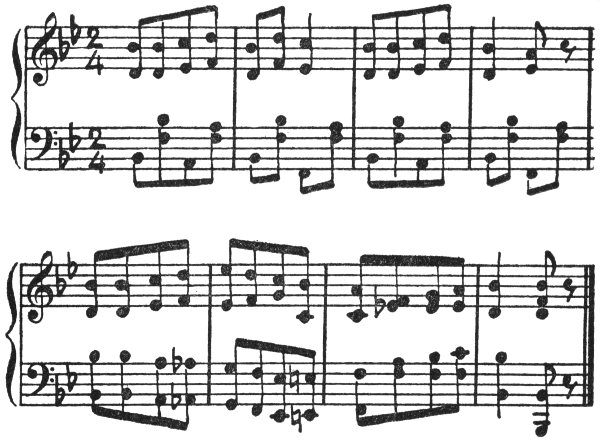
The Colonel proceeded to explain:
“We now have two phrases, the first ending with a Half-Cadence, the second with an Authentic Final Cadence. The first phrase is like a question and is called ‘Thesis’; the second phrase is like the answer to a question and is called ‘Antithesis.’ The two phrases together form a Period.
“Now, a Period is often a complete little composition all by itself, though it usually leads to something else. It is like a greeting between two friends who meet on the highway. One says:
“ ‘Morning, Mister A B C; how are you to-day, sir?’
“and the other replies:
“ ‘Thank you, Mister X Y Z; quite well, I’m glad to say, sir.’
“If they chose, they might sing those words to the notes you see there on the Staves. They would go together very well. Would you like to hear them sung?”
“Yes,” said Alice, “if you please.”
“Very well,” said the Colonel, and, turning to the notes, he cried: “Detail—’Ten—SHUN! Words and music—SOUND OFF!”
“Morning, Mister A B C . . .” sang the notes, fitting the Colonel’s verses to the tune they themselves represented.
“Oh!” cried Alice, as they finished, “now I know what the tune is. It’s ‘Yankee Doodle’ again.”
“I told you you’d recognize it,” said the Colonel. “Not a bad tune, is it?—even if it is an old one. But how do you like my new words for it?”
“Well,” said Alice, “they—they seem to fit.”
“Thank you,” said the Colonel, “that’s something. At any rate, my words serve to illustrate what I said about the Thesis and Antithesis, or question and answer. And now we’ll carry the illustration a step farther.
“After greeting each other, Mr. A B C and Mr. X Y Z may pass on without saying anything more. In that case their conversation would hardly be worth recording; and if a tune consisted of only one Period it would hardly be worth remembering. But suppose the friends continue their conversation—then, most likely, they will begin to talk about something else, for they would hardly go on asking each other how they were. The two gentlemen, therefore, must change the subject of their conversation if they are to say anything worth hearing. And the same thing is true of music. If we add another Period to the one we have, it must contain something new in order to hold the listener’s interest.
“Let us suppose that Mr. A B C continues the conversation thus:
“ ‘Down the road I saw a sight that truly was amazing:
In the field a purple cow on scarlet grass was grazing!’
“That would be an interesting bit of news, wouldn’t it?”
Alice laughed. “I should think it would!” she agreed.
“Well, then, I shall add another Period to the first one, and I think you’ll find that it is also new and interesting—though it will scarcely be as novel as the sight of a purple cow eating scarlet grass.”
The Colonel summoned a large detachment of notes and arranged them in a second Period of eight measures, forming a continuation of the first Period. The two Periods now appeared as follows:
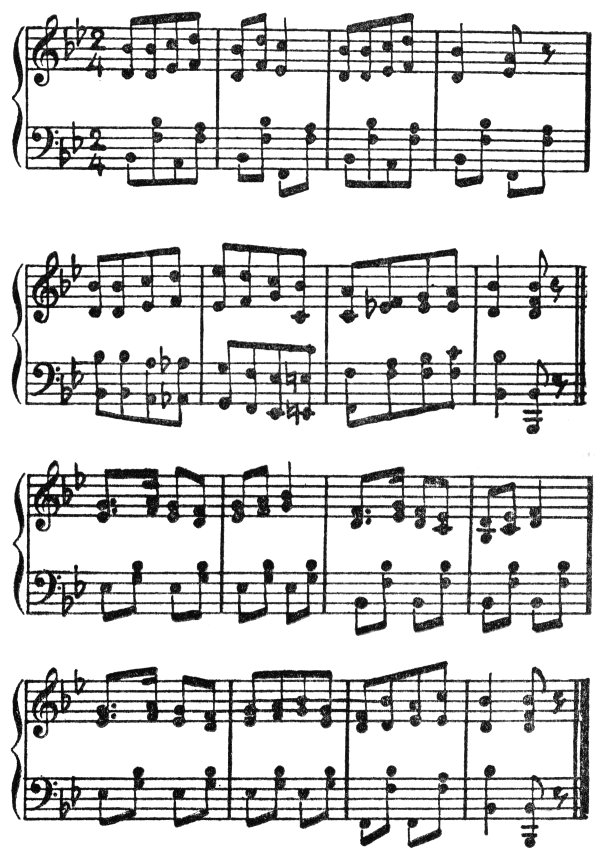
“Now,” said the Colonel, after the notes had sung the two Periods through from beginning to end, “our composition is really complete. It isn’t very long or very complicated, but it is well built, nicely balanced and artistically satisfying. It is composed, as you see, of two parts, each part consisting of a Period and each Period consisting of two Phrases. The Phrases correspond to each other, as the answer corresponds to a question; and the second Period contrasts with the first, as a new topic of conversation contrasts with an old one. Thus we have the simplest variety of musical form, which is called Two-Part Primary Form, or sometimes Two-Part Song Form, because it is used chiefly in composing songs.
“Music composed in Two-Part Form, however, is not always so short and simple. Sometimes the Phrases contain more than four measures, which makes the Periods longer and more complicated; and sometimes the Periods are repeated, which makes the piece twice as long. That gives you an idea of the way in which an elaborate composition may be built up from a very simple original plan. Many marches and dances, as well as songs, are in Two-Part Primary Form, and the Theme-with-Variations—one of the most elaborate kinds of composition—usually consists of a short piece in Two-Part Form which is repeated a number of times, each time with some change in the melody, the harmony, or the rhythm.
“The next form that we have to consider is the Three-Part Primary Form. It is more important than the Two-Part Form because it’s more symmetrical—that is, it’s better balanced and rounded off as a whole, owing to the fact that it ends in the same way it began. It consists of a First Part followed by a contrasting Second Part, and the Second Part is followed, in turn, by a Third Part which may be either an exact repetition of the First Part, or a repetition with some variation. Most of the minuets and scherzos in the classical sonatas and symphonies are in this form, and even Sonata Form, the largest and most elaborate of all forms, is derived from it.”
“I should like to see a piece in Three-Part Form,” said Alice. “Would you mind composing one for me—just a short one?”
“Unfortunately,” said the Colonel, “that is impossible. As I told you before, only generals can compose.”
“Don’t you expect to be a general some day?” Alice inquired.
The Colonel shook his head sadly. “No,” he said, “we are never promoted. But you might become a general.”
“I!” Alice cried, astonished. “Can a girl be a general?”
“Why not? If you learn all the rules and regulations you may find, when you’re a little older, that you have ‘inspiration.’ Then you may be a general, if you like.”
“Oh, I should like to be one!” said Alice. “I shall try with all my might. Please go on and tell me about Three-Part Form—quick!”
“Steady!” cautioned the Colonel. “We mustn’t go too fast—we might get mixed up. Dear, dear! It’s really too bad that the General is not here. He could compose a piece in Three-Part Form for you and show you exactly how it’s done, but——”
The Colonel broke off suddenly as a bugle call rang out in the distance.
“By Jove!” he cried, “the General is coming now. Quick, Captain—get these notes back in ranks and call out the whole command!”
As the Captain hastened to obey the Colonel turned to Alice.
“The General is a very great genius,” he said, “and we must receive him with all the courtesies due to his rank.”
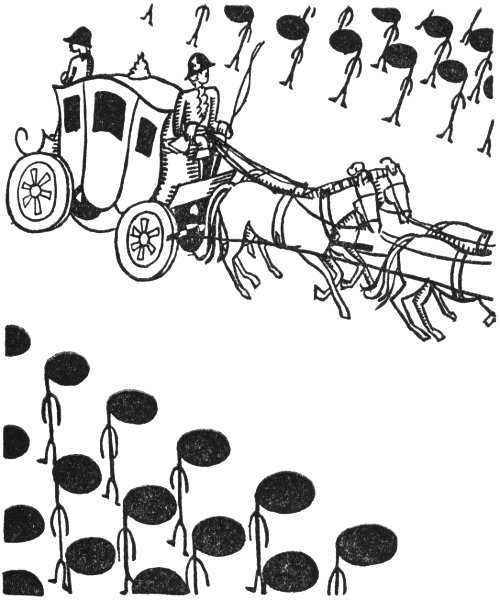
THE GENERAL ARRIVES
For a few moments all was confusion. Officers shouted commands, notes dashed hither and thither, and from the Parade Ground behind the Staff came sounds of bustle and excitement. Presently, however, order was restored. Captain Key’s company, formed again in two long ranks, stood rigidly at attention, while through an archway under the Staff came marching the entire garrison of the post. On they came, company after company in column of squads, with drums beating and colors flying, until half of the command had passed the spot where Alice and the Colonel were standing. Then, at the command “Squads left!” the column swung into line, facing the Staff, and halted.
Alice was surprised to see that the line, instead of being perfectly straight, like that of Captain Key’s company, bulged here and sagged there in an unsightly manner. Feeling that something ought to be done about it, she decided to mention the matter to the Colonel.
“Aren’t they supposed to stand in a straight row?” she asked.
“Certainly,” said the Colonel.
“But they’re all zigzaggy,” said Alice.
“They’ll straighten out as soon as they’re dressed,” the Colonel assured her. “The officers are going to dress them now.”
“Dear me!” said Alice, “they seem to have on plenty of clothes. And, anyhow, I should think they were able to dress themselves.”
The Colonel laughed heartily. “That’s a good one!” he exclaimed. “I must tell it to the Mess. Fancy an officer tying his soldiers’ shoe laces and brushing their hair! What a spectacle!”
Alice didn’t see the joke. “But,” she insisted, “you said that the officers were going to dress them.”
“So I did,” said the Colonel, still chuckling; “but, you see, dressing a company is very different from dressing a soldier. It means placing it so that it’s in line with the other companies, and so that each man is in line with the other men. There, you see—they’ve dressed the whole regiment, and the line is straight as a string. Does that suit you?”
“Yes,” said Alice, nodding her head approvingly, “that looks much better.”
The band began to play a lively march, and Alice’s heart began to beat faster and faster. She could scarcely believe that she was actually going to see the great General. She wondered what kind of person he would turn out to be—very splendid, she supposed: tall, like the Colonel, with gray hair, and wearing a magnificent uniform all covered with gold braid and medals. Of course, he would be mounted on a fiery charger and followed by a guard of honor, and he would probably carry a sword with a jeweled hilt.
Just then her speculations were interrupted by a fanfare of bugles.
“There he comes!” cried the Colonel, pointing out across the plain.
Alice looked in the direction indicated and saw a cloud of white dust moving swiftly toward the Staff. Nearer and nearer it came, but the dust was so dense that Alice could not see what caused it. As it reached the end of the regimental line, however, its speed slackened, and presently it dispersed sufficiently for Alice to see a curious old-fashioned coach, slung by leather straps from high, curved springs, and drawn by four white horses. The driver, who was dressed in knee breeches, a long brown coat, and a three-cornered hat, pulled back on his reins, and the horses came to a stop, rearing and prancing. At the same moment a footman, dressed like the driver, jumped to the ground and ran to open the door. As he did so the bugles blew another fanfare, the drums rolled, the officers all drew their swords and saluted—and out of the coach stepped a little boy.
He was dressed, like the coachman and footman, in knee breeches and a long coat; but his clothes were made of blue satin, and from the high stock around his neck fell a cascade of fine lace ruffles. He wore no hat, and his hair, which was long, and white with powder, was tied at the back with a blue ribbon. His stockings were of white silk, his shoes had red heels and silver buckles, and in his hand he carried an enormous quill pen, taller than himself.
Alice thought there must be some mistake. This pretty little boy, far younger than herself, could not possibly be the General of whom she had heard so much. Had somebody played a joke on the Colonel? The Colonel wouldn’t think it very funny, she imagined, after all the preparations he had made to receive an important visitor. The idea of ordering out the whole regiment just to meet a little boy with powdered hair! She turned to see how the Colonel was taking it, but he had left her side and was walking toward the little boy.
At a few paces distance the Colonel halted and saluted again with his sword.
“The regiment welcomes you, sir,” he said with the greatest deference.
The little boy bowed gravely and replied:
“Thank you. It’s a nice regiment. I like to see them standing so stiff and straight.”
The Colonel bowed. “We are proud of our discipline,” he said, “and I am happy to know that it meets with your approval, sir.”
The little boy bowed again, and the Colonel, who seemed determined to have the last bow, also bowed again. Just as he was about to return the Colonel’s second bow the little boy caught sight of Alice.
“Who is that?” he demanded, stopping in the middle of his salutation and pointing at Alice with his great quill pen.
“A visitor to the post,” replied the Colonel.
“What’s her name?” the boy inquired.
“Why, I’m sorry, sir,” the Colonel apologized, “but I have neglected to inquire what her name is.”
“Tell her to come here,” said the boy.
The Colonel beckoned to Alice, who approached without hesitation.
“How do you do?” the boy inquired politely. “What is your name?”
Alice told him.
“What a funny name!” he cried, laughing. “I never heard it before. My name is Wolfgang.”
It was Alice’s turn to laugh. “Why,” she said, “I think Wolfgang is lots funnier than Alice.”
“Don’t be silly,” said the boy. “There’s nothing funny about my name; but Alice is funny.”
“Well,” said Alice, “I s’pose any name sounds funny when you’re not used to it. What’s your other name?”
“Which one do you mean? I’ve got five.”
“Five names!” cried Alice, astonished. “What are they?”
“Johannes Chrysostomus Wolfgangus Theophilus Mozart. But they generally call me Wolfgang Amadeus Mozart, for short.”
“Mozart!” Alice exclaimed. “Did you say your name was Mozart?”
The boy nodded. “Yes—and it’s not a funny name,” he added defiantly.
Alice was nonplussed. Mozart was the name of the composer of her minuet; but surely this little boy, clever though he seemed to be, could not have written that music. Composers, she took it for granted, were always grown-up people; but perhaps Wolfgang was older than he appeared. She had heard of dwarfs that looked like little boys but were really grown men. Perhaps Wolfgang was a dwarf.
“How old are you?” she demanded suddenly.
“I shall be five next birthday,” he replied.
“Then he’s not a dwarf,” said Alice to herself. “There must be a mistake about his name. Excuse me,” she said aloud, “but are you sure your name is Mozart?”
“Of course,” said the boy. “What a stupid question!”
“Well, you see,” Alice explained, “there was a famous composer named Mozart; but you’re not a composer, are you?”
“Not yet; but I’m going to be. I haven’t composed anything yet except exercises, but I’m going to compose real music—lots and lots of it. I’m going to compose a piece now. That’s what I came here for.”
“Do you mean to say that you know how to compose music already?”
“Oh, yes,” said the boy quite casually. “Don’t you?”
“Goodness, no!” said Alice. “I wish I did, but there are so many rules to learn, and I’ve only just begun to learn them.”
“They’re easy,” said the boy. “My father could teach them to you in no time. Maybe, though, they’re harder for girls than for boys. My sister Marianne, who’s just about as big as you are, can play the harpsichord like anything, but she has lots of trouble with her harmony and counterpoint. My father says he doesn’t believe she’ll ever be a composer. Now I’ve got to start to work, or I shan’t get home in time for dinner.”
“May I watch you?” Alice inquired somewhat shyly. She was beginning to feel rather in awe of this remarkable boy, and she understood why the Colonel treated him with so much deference. There was a strange look of intelligence in his eyes which made him seem far older than his years. Otherwise he was like any boy of five, except that he seemed to have a pleasanter disposition and better manners than some boys Alice had met.
“You may watch me if you like,” he said in reply to Alice’s question; “only, please don’t interrupt or make any noise. It might spoil my piece.”
Alice promised that she would be very quiet, and the little boy clambered up the steps and set to work at his composition.
The Colonel, who had listened smilingly to the conversation between the two youngsters, now leaned down and whispered in Alice’s ear:
“Come, let us stand over there, farther from the Staff, so that the sound of our voices will not disturb him. You will still be able to see all that he does, and I can explain whatever you don’t understand.”
They retreated to a little knoll, some distance away, from the top of which they could see all that happened on the Staff.
“Doesn’t he need you to help him command the notes?” Alice inquired.
“No,” said the Colonel, “he can get along perfectly by himself. He’s a genius, you know, and the notes will obey his slightest sign.”
“How can you tell that he’s a genius if he hasn’t composed anything yet?”
“Ah,” said the Colonel, “we always know by the gleam in their eyes. And just see how he goes about his work. He’s as sure of what he’s doing as if he were fifty years old instead of five.”
The boy was moving quickly along the Staff, running up and down and pointing first to one step, then to another, with his long quill. And on each spot he indicated a note promptly took its place, or a bar-line was put in position. At the end of the eighth measure he made two signs with his quill, and a double bar was laid vertically upon the Staff. Then he made two more signs, and a pair of dots was placed on each flight of steps, just to the left of the double bar.
“There,” said the Colonel, “he has already finished his first Period. The dots to the left of the double bar mean, of course, that he intends the preceding Period to be repeated. Now he is placing dots to the right of the double bar. That means that the next Period is to be repeated too.”
“What kind of a piece is it going to be?” Alice inquired.
“Well,” said the Colonel, “it is in three-four rhythm, and the tempo is Allegro. Therefore I should say that it is going to be a quick minuet. Now let us see what else we can find out about it. The key signature, as you see, is one Sharp, which stands for G major or E minor. If the piece is in E minor you will find an accidental D-sharp somewhere near the beginning, for D-sharp is the Leading Tone of E minor. Do you see a D-sharp anywhere?”
Alice scanned the measures of the first Period, but could find no D-sharp.
“No,” she said, “every D is natural.”
“Then the key is G major,” said the Colonel. “The next thing we notice is that the measure—or part of a measure—before the first bar-line contains only two eighth notes, or one beat. That means that the first Section begins with what we call the ‘up beat’—the last beat of a measure; and you’ll find that the Period ends with the next to the last beat of the eighth measure. Many pieces begin this way—on some beat other than the first beat of the measure; and when they do you’ll find that they usually end on the beat just preceding the corresponding beat of the final measure.
“We also notice that thus far the piece is in two-part harmony. That is, only two notes are to be sounded together at any point in the first Period—one note in the treble and one note in the bass.”
“I s’pose,” said Alice, “that makes it easier to compose than if there were more parts.”
“I’m not so sure of that,” said the Colonel. “Of course, you have fewer notes to handle, but with only two parts it’s hard to make your harmony sound complete. A chord, you know, has at least three notes; therefore, when you write for only two parts you are obliged to leave out at least one note of every chord. The difficulty is to know which of the three notes is the least important and consequently the best one to leave out—and, at the same time, to keep your two voices moving smoothly along instead of jumping about like jack rabbits. No, I should say that it is decidedly harder to compose effectively for two parts than for three or four.
“Now let me call your attention to the fifth measure, not counting the part of a measure at the beginning. What is the last note of that measure, in the treble part?”
“C-sharp,” said Alice.
“Right; and since C-sharp does not belong to the key of G, it means that a modulation, or change of key, takes place there. As a matter of fact, the rest of the Period is in D, the Dominant of G, and it ends with an Authentic Final Cadence in the key of D major. This Period constitutes the Thesis of the first Part of the piece. Now let us see what the Antithesis is like.”
While the Colonel had been talking the boy had finished another Period of eight measures. This Period the Colonel studied for a moment; then he proceeded to explain it.
“The second Period begins with another modulation, this time to the key of A minor, as indicated by the G-sharp and F-natural, G-sharp being the Leading Tone and F-natural the minor sixth of A minor. But in the third measure we return to G major, and the Period ends with an Authentic Final Cadence in G. Thus we have the usual ‘question-and-answer’ construction. The first Period, or Thesis, ends on the Dominant, which is like a rising inflection of the voice in speaking; the second Period, or Antithesis, replies to the first by ending emphatically on the Tonic. The word Fine at the last measure of the second Period means that the piece is to end there.”
“But,” said Alice, “he seems to be going right on, composing more.”
“Certainly,” said the Colonel; “the first two Periods constitute only the first Part of the piece. Now he’s composing the second Part, which is called the ‘Trio.’ ”
“Why is it called ‘Trio’?” Alice demanded.
“Because,” the Colonel explained, “it is in three-part harmony. ‘Trio’ means ‘three,’ or ‘triple,’ and there are now three separate parts instead of two. The second Part of a composition, you remember, must introduce something new. In this case our young composer not only brings in a new subject, but he announces it in a new key—C major—and in a different kind of harmony. And he’s not yet five years old!”
The boy had now arrived at the end of his fourth Period. This, the Colonel explained, completed the second Part of the composition.
“If the piece ended here,” he went on, “it would be in Two-Part Form, like ‘Yankee Doodle’; but at the end of the Trio you see the words Menuetto da Capo al Fine, which means that the first Part is to be played over again, from the beginning to the place marked Fine. Thus the piece ends with a third Part exactly like the first.”
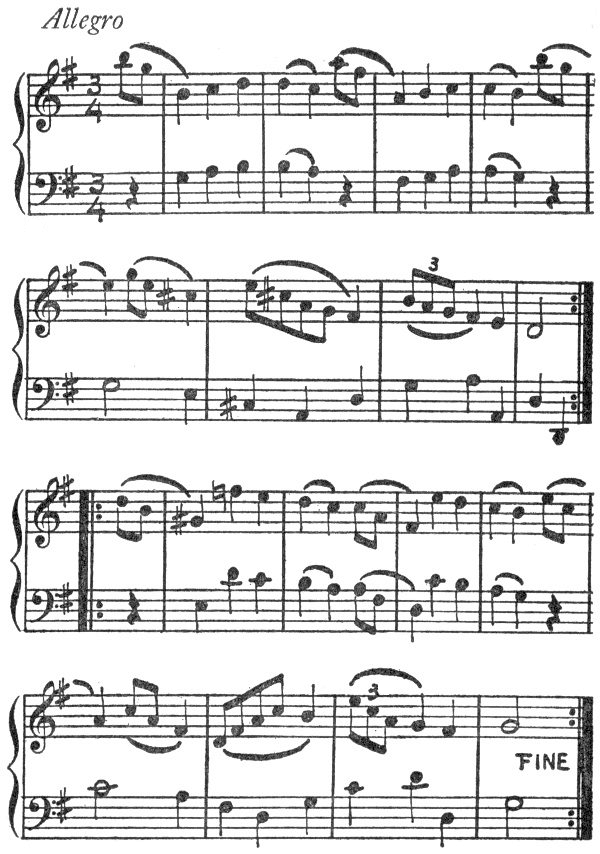
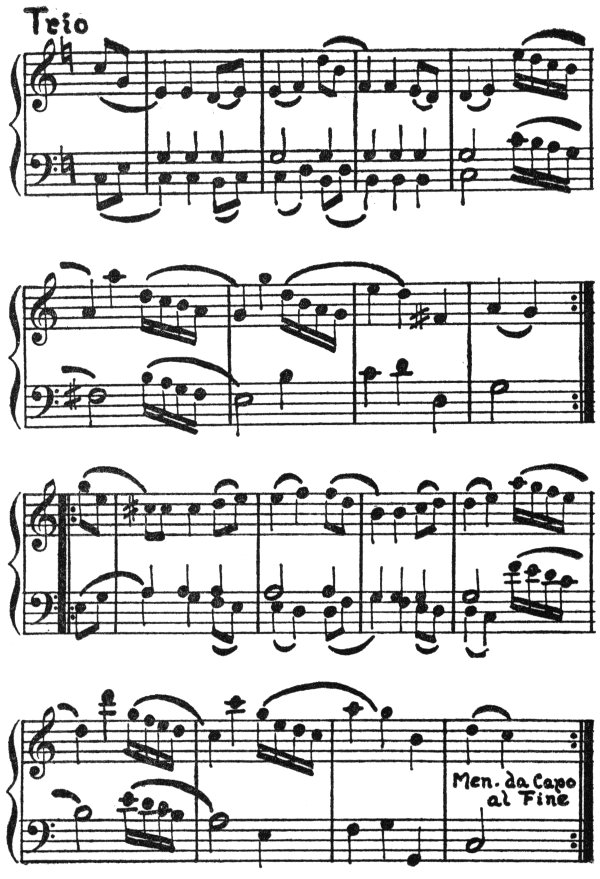
“And there you have an example of Three-Part Primary Form, composed before your very eyes by a musical genius. Of course, this is a very simple little piece; but it’s a perfect one of its kind. There’s no doubt about it—that little chap will write great music one of these days.”
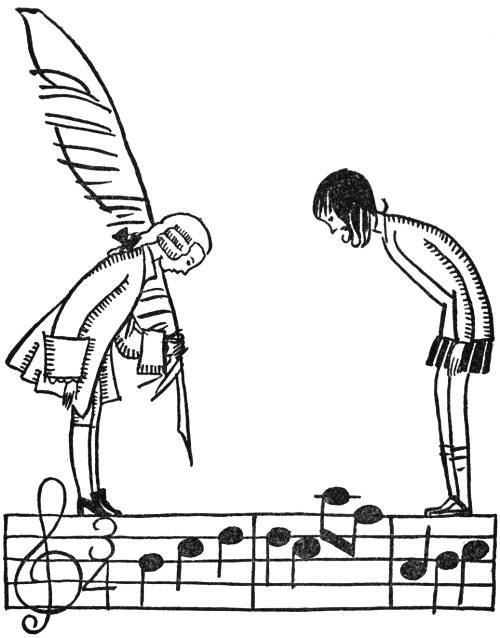
THE GENERAL DEPARTS
Alice gazed with intense interest at the music composed by the little boy, and the longer she looked at it the more it seemed to her that she had already seen it elsewhere. She wished ardently that she could “hear it with her eyes,” as the Colonel had said; but the notes gave her only vague suggestions of sounds—although, she was pleased to discover, she could feel the rhythms they represented. She was just about to ask the Colonel if he wouldn’t be kind enough to have the notes sing this piece, as they had sung the “refreshment,” when the little boy clambered down the steps of the Staff and came toward her.
“Good-bye,” he said. “I’m going home now.”
“Good-bye,” said Alice. “I’m very glad to have met you, and I think it’s wonderful how well you compose. I’m sure your piece must be beautiful—but I do wish I could hear it played.”
“I’ll play it for you, if you like,” the boy offered.
“Oh!” cried Alice, “that would be lovely. But what will you play it on? There’s no piano here.”
The boy seemed mystified. “Piano?” he repeated. “What is that?”
“Why,” said Alice, “it’s a musical instrument, of course. I thought everybody knew what a piano is. It has black and white keys, and little hammers that hit the strings, and——”
“Oh,” the boy broke in, “you must be talking about those newfangled things they call ‘forte-pianos.’ I’ve heard of them, but I’ve never seen one. Anyhow, I don’t believe they’re as good as harpsichords and clavichords. I’ve got a splendid clavichord in the coach. Just wait a minute and I’ll show it to you. Here, Johann!” he called to the footman. “Bring me my clavichord.”
The footman disappeared into the coach, and presently emerged, carrying in his arms a large oblong box made of reddish-brown wood lavishly decorated with inlaid designs.
“Put it there, on the table, Johann,” the boy commanded.
The footman deposited the box on the little marble-topped table under the umbrella, and the boy stepped forward and raised the lid.
“There!” he said proudly. “Isn’t it a beauty?”
Alice drew near to examine it. Along the front of the box was a row of keys like the keys of a piano, only there were not so many of them. Inside there were wire strings, stretched at right angles to the keys, and all of the same length. These strings were thinner than piano strings, and instead of hammers to strike them there were little upright pieces of brass, fixed to the inner ends of the keys.
“Why,” said Alice, “it looks like a kind of toy piano. It’s very pretty, though,” she hastened to add, seeing the little boy’s eyes flash ominously at the word “toy”; “and I’m sure it must have a lovely tone.”
“I should think it has!” said the boy emphatically. “Just wait—I’ll show you.”
He seized the wicker chair which Alice had previously sat upon and moved it, with some difficulty, up to the table. Then he scrambled onto its seat, settled himself comfortably, and ran his fingers up and down the keys of the clavichord, which gave out a series of delightful tinkling tones, not loud, but of a charming, delicate quality.
“How pretty!” Alice exclaimed. “And how wonderfully you play!”
“That’s nothing,” said the boy modestly. “You ought to hear my sister Marianne play. We’re going to make a concert tour together next year. Now I’ll play you my minuet.”
He glanced at the notes on the Staff, then, closing his eyes, began to play by heart the piece he had composed. As he finished the first Phrase Alice gave a start.
“Why!” she whispered excitedly to the Colonel, “that’s the piece I was practising this morning. I thought it looked familiar. Then he didn’t compose it, after all.”
“Oh, yes, he did,” the Colonel retorted. “You saw him do it.”
“But,” Alice objected, “how could I have played it this morning if it wasn’t composed until this afternoon?”
“You’ve got your dates confused,” said the Colonel. “This morning you were in the Twentieth Century, and now you’re in the Eighteenth. In this country time can go backward as well as forward. Just now we’re in the year 1761.”
“Goodness gracious!” Alice exclaimed. “That’s more than a hundred and fifty years before I was born. I don’t see how I can be here.” She touched herself, to make sure that she really did exist.
“Never mind,” said the Colonel. “You are here, and that’s all that matters. Now let’s listen to the youngster’s minuet. You may never have another opportunity to hear it played by the composer.”
Alice dismissed the puzzling question of time from her mind and gave her attention to the music. It was even more beautiful and interesting, she decided, than it had seemed when she had tried to play it herself. That, of course, was partly due to the fact that the young composer played it better than she had been able—better, perhaps, than she would ever be able—to do; but it also seemed to Alice that the delicate, tinkling sound of the clavichord was more appropriate than the robust tone of the piano to music of such quaint, old-fashioned elegance.
As the performance went on, Alice was delighted to find that she could follow the plan of the piece quite well, recognizing the different Cadences and keeping track of Phrases, Periods, and Parts as they succeeded one another. This, she discovered, was fascinating—a sort of new and interesting game which one could play all by one’s self, and which added enormously to one’s enjoyment of music.
When the minuet was ended Alice clapped her hands enthusiastically.
“That was lovely!” she cried. “Thank you so much for playing it!”
“You’re welcome,” said the boy. “I’m glad you liked it. It’s only a little piece—but soon I shall be composing sonatas and symphonies—and operas. If you like you may come and watch me.”
“I should like to, very much,” said Alice, “but I don’t know whether I can find the way to this place again.”
“That’s easy enough. Just tell your coachman to drive you to the Musitary Post. He’ll know the way.”
“But I haven’t any coachman,” said Alice, “nor any coach.”
The boy seemed surprised. “Haven’t you?” he said. “That’s too bad! Well, I’ll tell you what—I’ll send mine to fetch you.”
“Thank you,” said Alice. “That’s very nice of you; but your coach would have to travel a terribly long way, I’m afraid—more than a hundred and fifty years.”
The boy appeared not to understand. His eyelids were beginning to droop a little, and he stifled a yawn.
“I must go,” he said. “It’s almost bedtime, and—and I’m hungry.”
He slid down from the seat of the chair and walked slowly toward his coach. When he had climbed into it he turned and waved his hand to Alice and the Colonel. Alice waved her hand in reply, the Colonel saluted, and the bugles burst into a last fanfare. Then the footman folded up the steps, slammed the door of the coach and sprang to his seat as the equipage dashed away in the direction from which it had come.
Alice watched until it was lost to sight in the dust and distance. Then she said with a sigh:
“I’m sorry he’s gone. He was such a nice little boy.”
At that moment her eye happened to fall upon the table under the umbrella.
“Oh, dear!” she cried, “he’s forgotten his clavichord. There it is, on the table, with its lid still open.”
“Well, well—so it is,” said the Colonel. “I’m afraid he’s rather a heedless youngster. He’ll have his troubles later on if he doesn’t learn to be more careful.”
“Can’t you send somebody after him,” Alice suggested, “to let him know he’s left it behind?”
The Colonel shook his head. “He’s too far away by this time. Anyhow, it doesn’t greatly matter. It will be here waiting for him the next time he comes. And I fancy that will be soon. He’ll be setting to work at his sonatas and symphonies before long.”
“What are sonatas and symphonies?” Alice demanded.
“They are forms of musical composition,” said the Colonel, “just as the minuet is a form of musical composition; but the sonata and the symphony are much more elaborate. The sonata consists of a set of pieces written for one or two instruments. There are usually three or four pieces in the set, and each piece is called a ‘movement.’ The sonata takes its name from the first of these movements, which is always in Sonata Form. There isn’t time now for me to explain Sonata Form to you in detail, but you will get a general idea of it if you imagine a composition in which the principle of Three-Part Form is carried out on an enormously larger scale. There is a First Part, called the Exposition, in which the composer presents his themes, of which there are usually two. Then there’s a Second Part, called the Development, in which the composer takes the themes he had introduced in the First Part and shows how cleverly he can handle them. He changes them in various ways, presenting them in new keys, turning them upside down and inside out, and taking them apart and tossing the bits about as a juggler tosses his colored balls. It’s amazing what a great composer can do with his themes when he sets out to develop them.
“After the Development comes the Third Part, called the Recapitulation. In this Part the themes return in their original form, to round off the movement and give the listener a feeling that the work is finished and complete.
“The second movement of the sonata is usually a slow one, sometimes a Theme-with-Variations, sometimes a sort of song without words, in Three-Part Form. The third movement is generally a minuet or a scherzo—which is like the minuet, but livelier, often decidedly comical. The last movement may be in Sonata Form, in Theme-with-Variations Form, or in Rondo Form. This last form, which is the one most often found in fourth movements, consists of a theme, or Part, which appears several times, followed each time by a new Part, or interlude, introducing fresh musical ideas. Finally the original theme returns once more, to bring the movement to a proper close.
“In form a symphony is just about the same thing as a sonata, the chief difference being that it is composed for a whole orchestra instead of for one or two instruments. Trios are sonatas written for three instruments, quartets are sonatas for four instruments, and so on.”
The Colonel paused and consulted his watch.
“Now,” he said, “I must send the regiment back to the Parade Ground, as it’s nearly time for retreat. If you want to learn more about musical form you will have to visit us again another day. Meanwhile, I hope you will not forget what you’ve already learned.”
“I shall try to remember every bit of it,” Alice promised. “And I do thank you ever so much for all the trouble you’ve taken.”
“No trouble at all,” said the Colonel cordially. “On the contrary, it’s been a pleasure.”
Alice cast a wistful glance at the table.
“Do you s’pose,” she asked timidly, “that the—the General would mind if I played a little on his clavichord before I go?”
“I think he’d be pleased to have you use it,” said the Colonel. “What would you like to play?”
“Well,” said Alice, “the notes of his minuet are still there on the Staff. I should like to see whether I can play them any better than I could this morning.”
“Very well,” said the Colonel. “Go ahead.”
Alice seated herself at the clavichord and began to play. Somehow her fingers seemed to find the keys much more readily than usual. She scarcely had to think about what she was doing, and presently she fell into a kind of reverie in which her thoughts were vague but very pleasant. After a time she became aware that the Staff and the notes had grown much smaller. Then she noticed that the clavichord had grown larger. It had more keys now than when she had begun to play on it, and, instead of resting on a table, it stood on legs of its own. Also its tone had grown stronger.
Suddenly Alice gave a start, and her hands fell from the keyboard.
“Well, of all the queer——” she began, and then stopped and stared, and rubbed her eyes, and stared again.
The clavichord was not a clavichord at all, but a piano—her own piano, in her own home; and on the music rack stood a piece of music entitled
MINUET NO. 1, with TRIO
by W. A. MOZART
THE END
TRANSCRIBER NOTES
Misspelled words and printer errors have been corrected. Where multiple spellings occur, majority use has been employed.
Punctuation has been maintained except where obvious printer errors occur.
[The end of Marching Notes by Ernest La Prade]